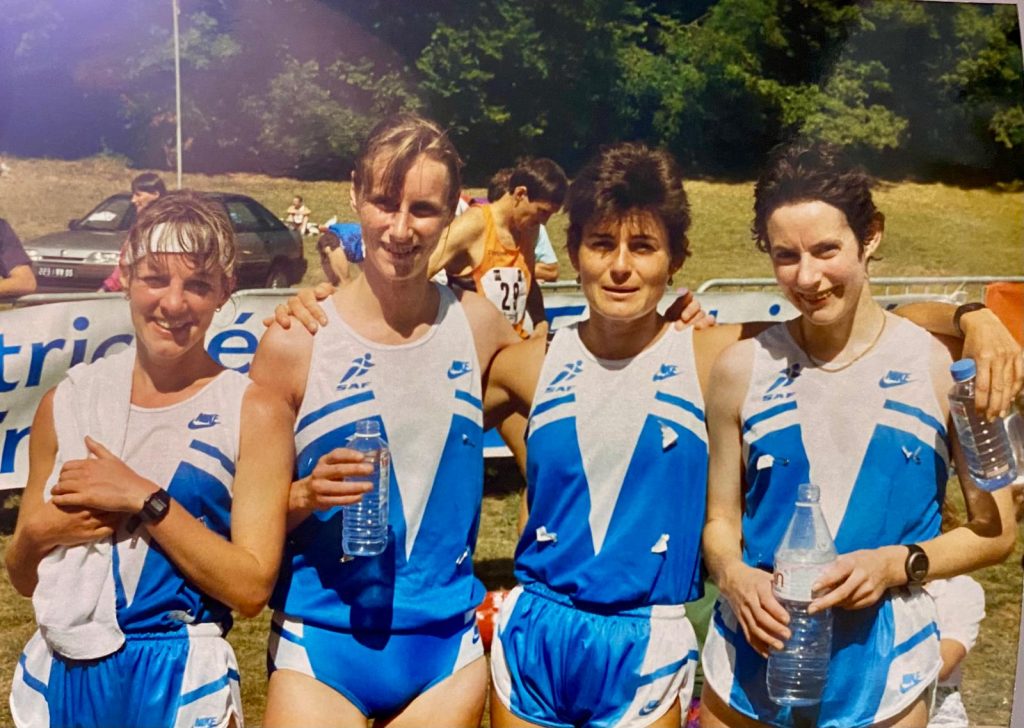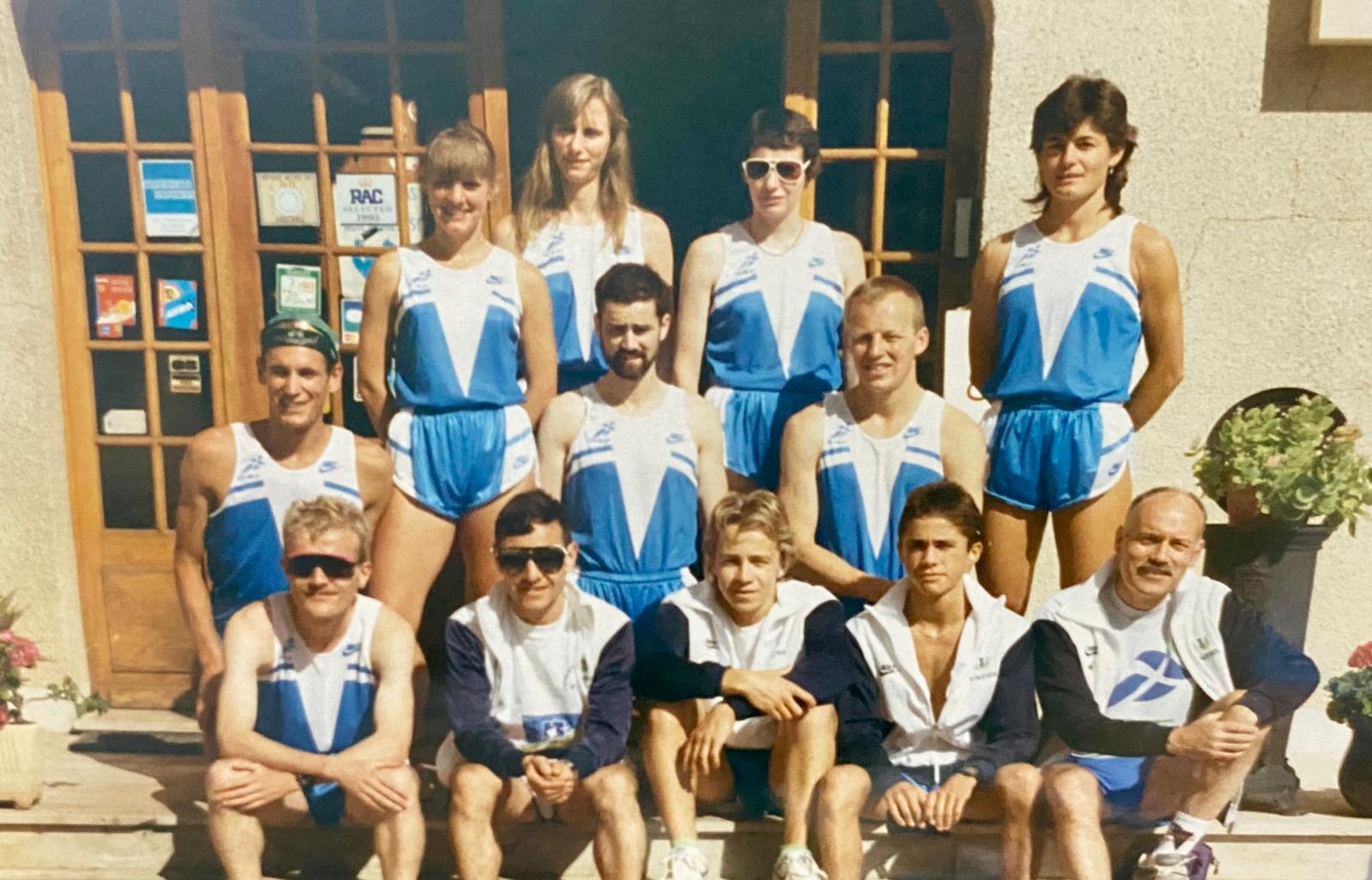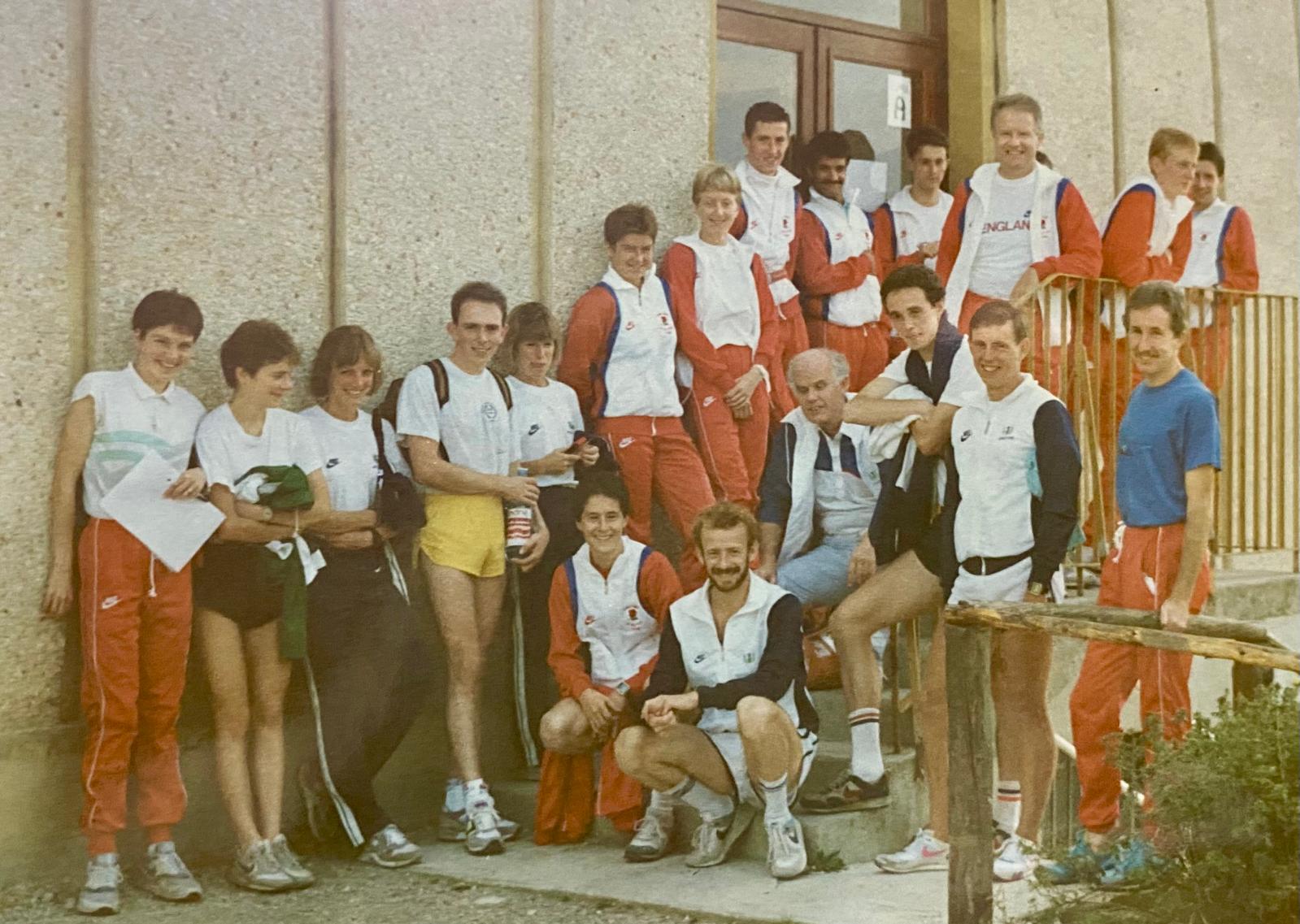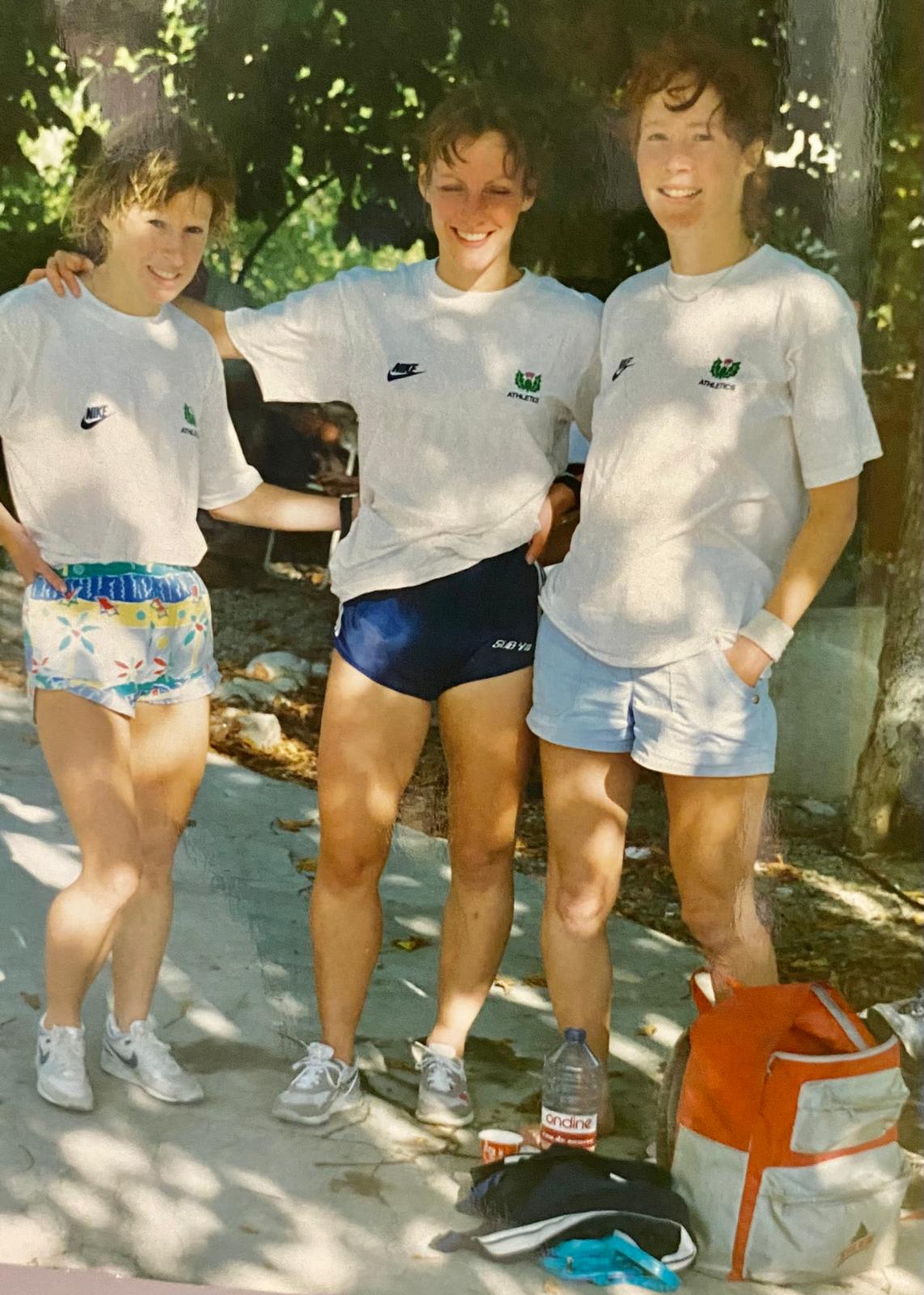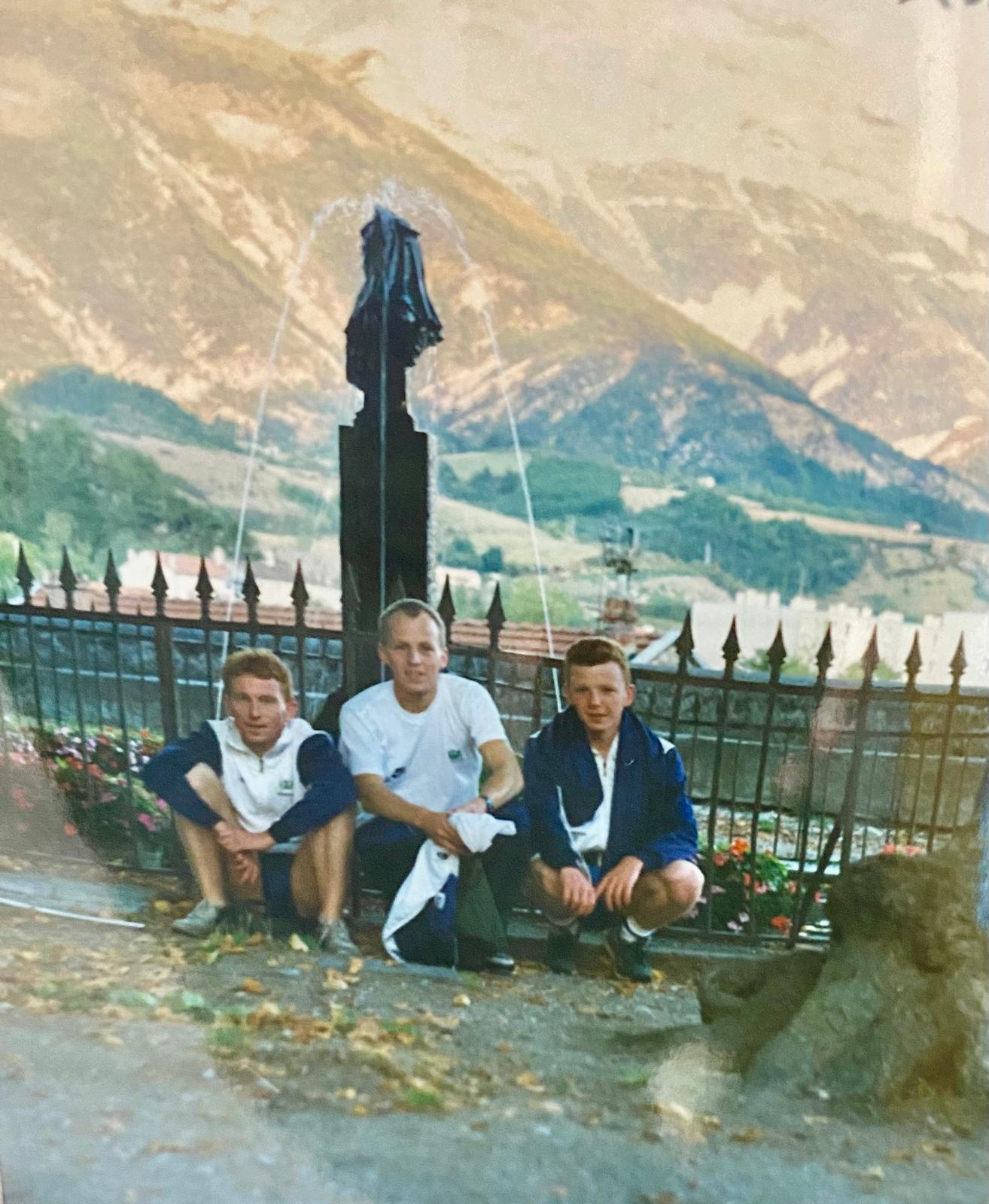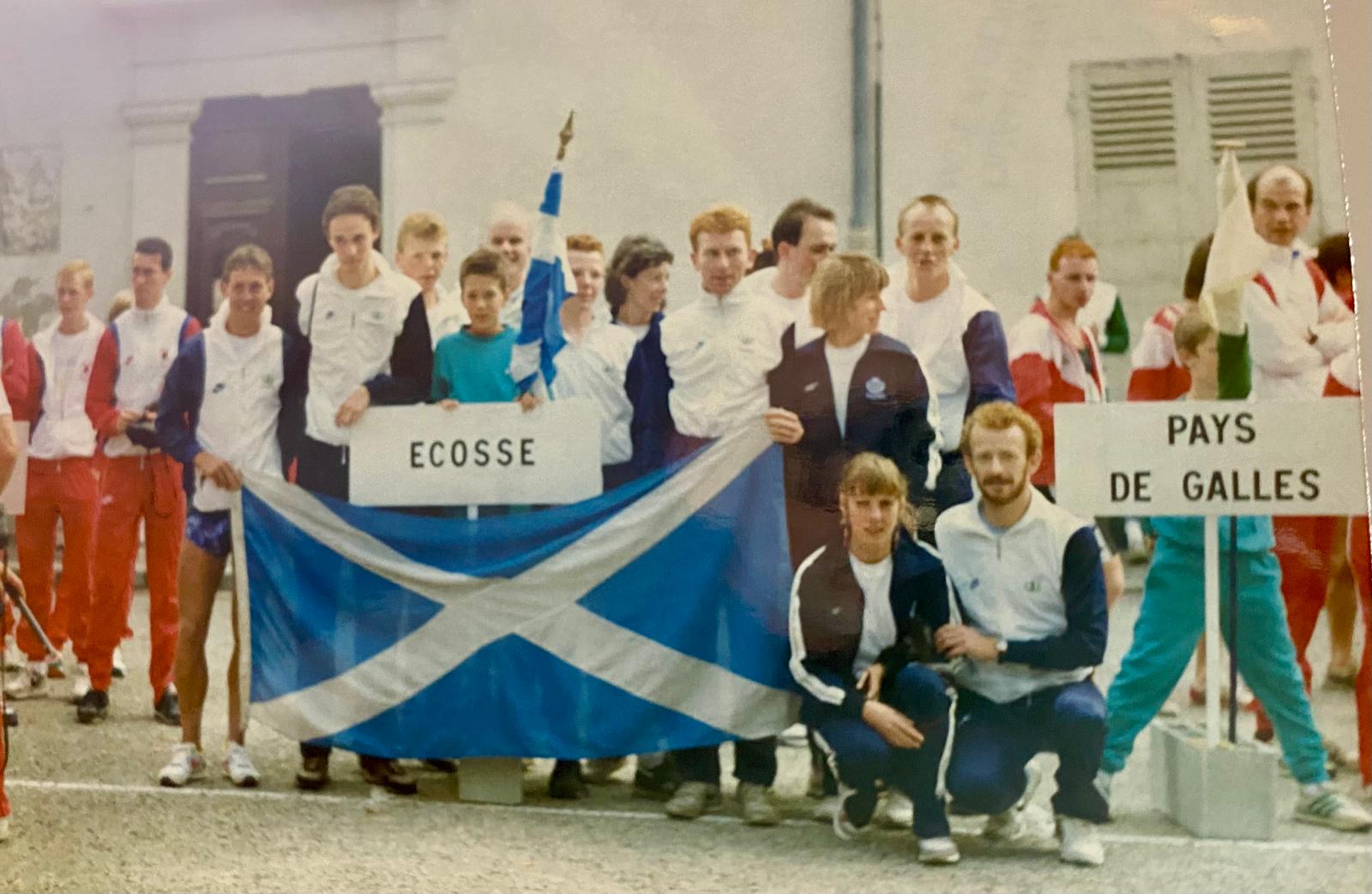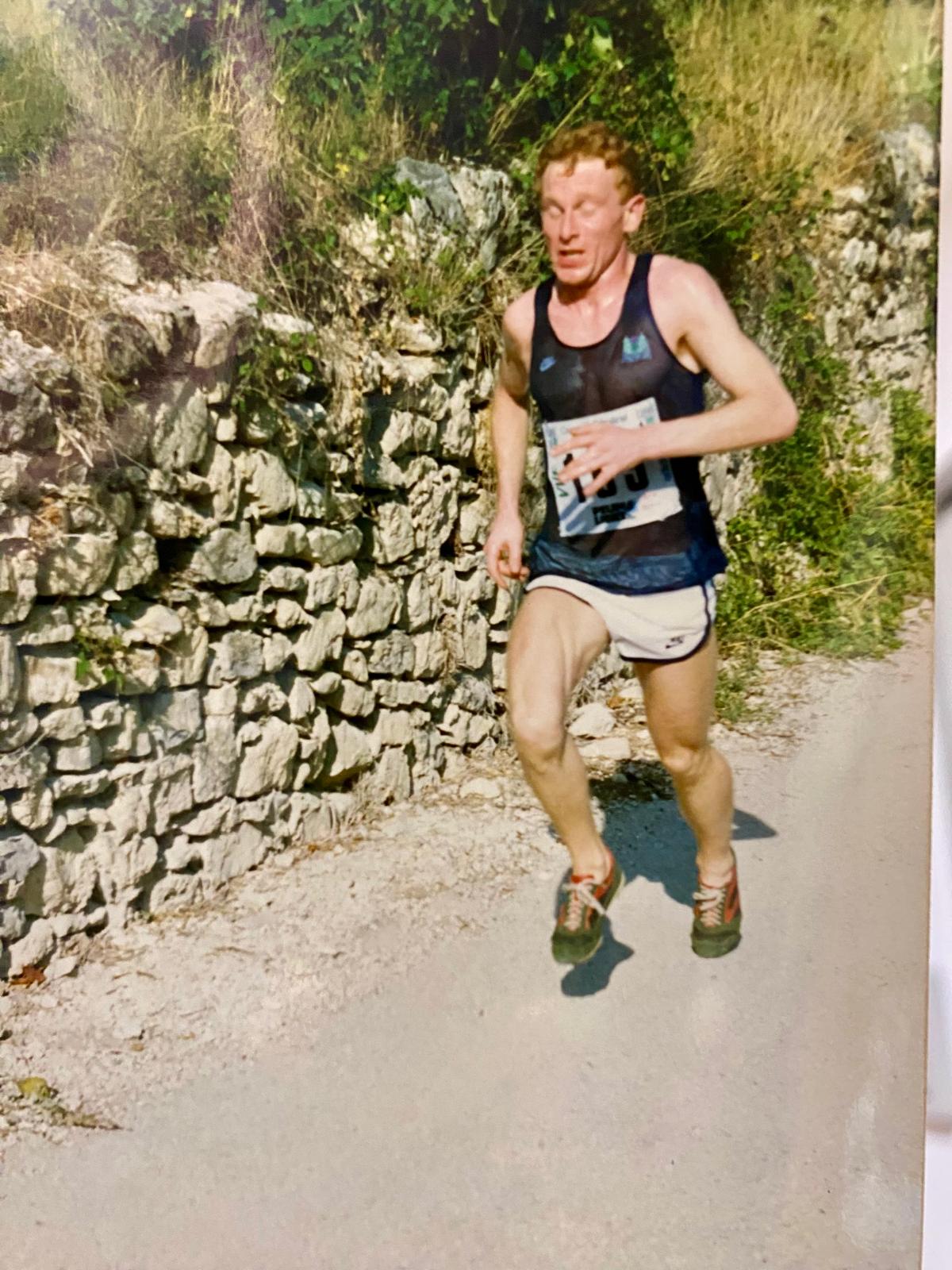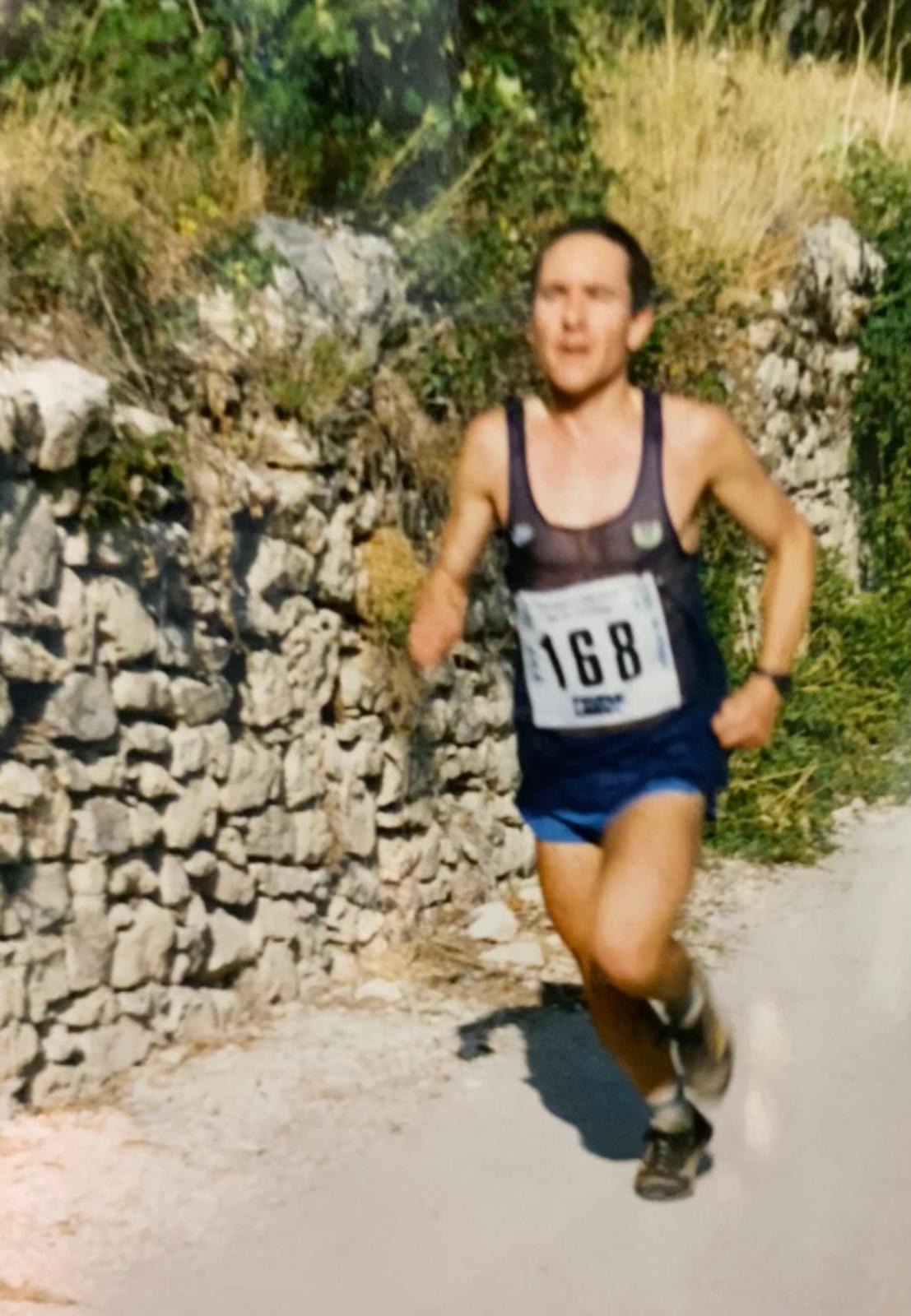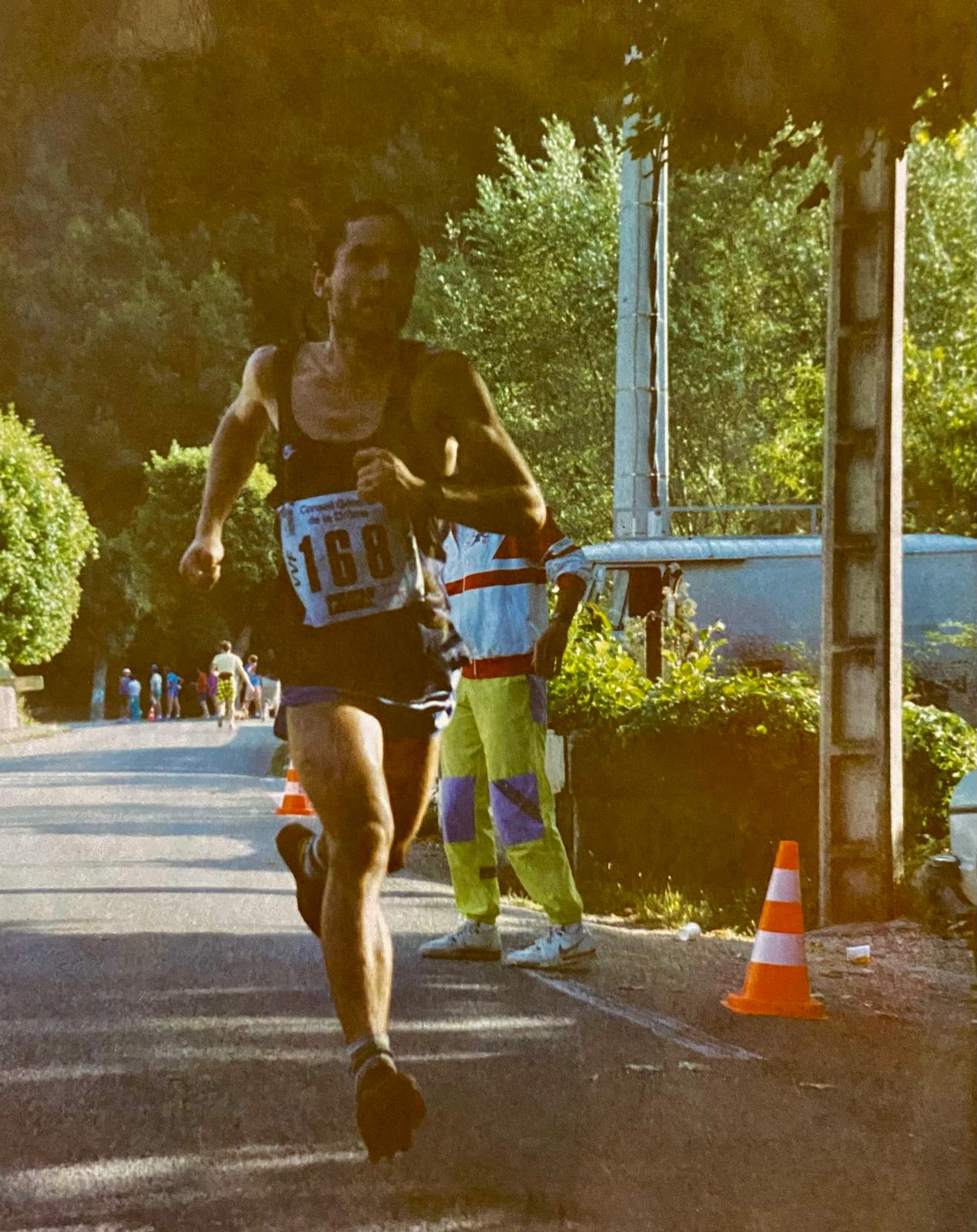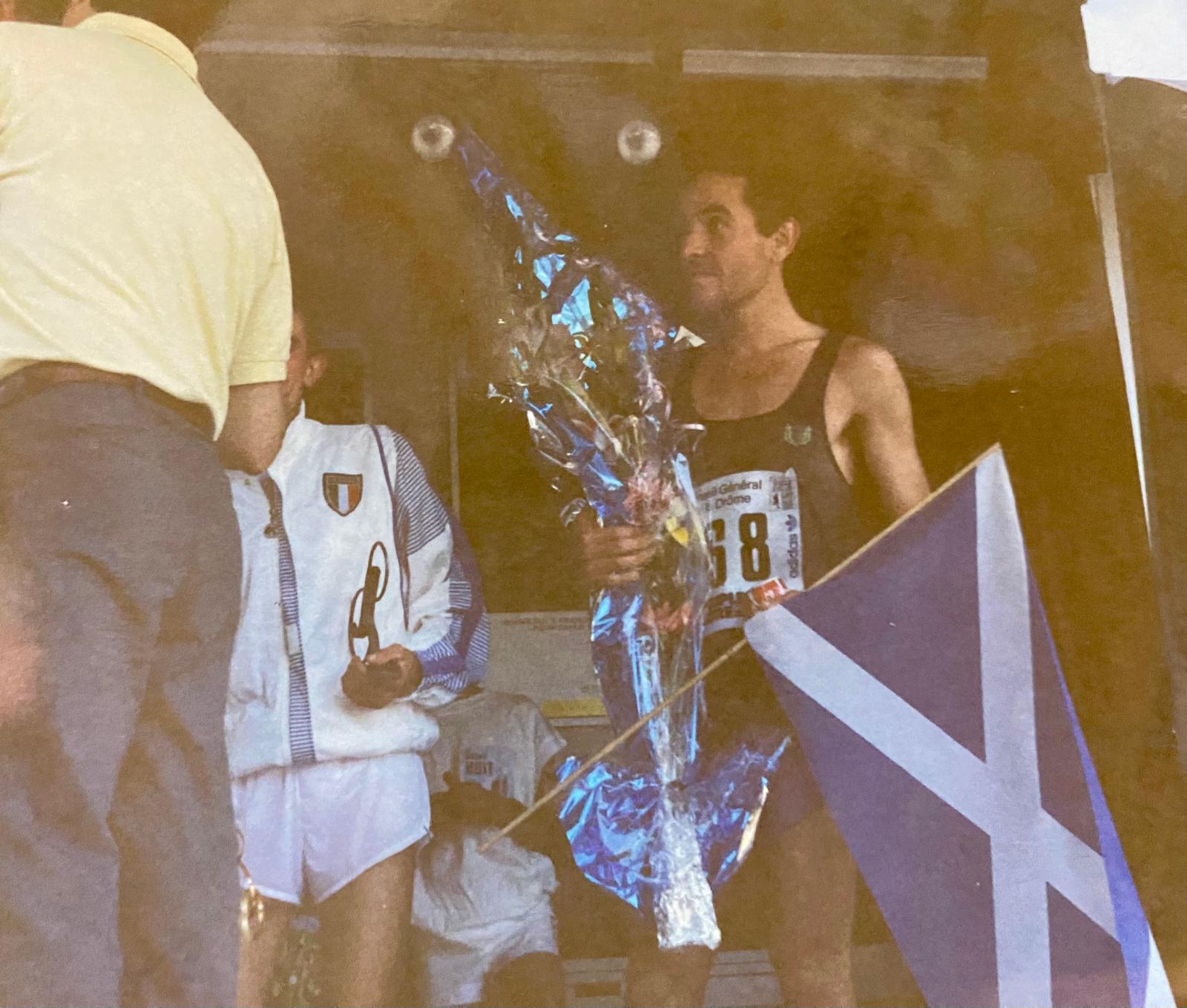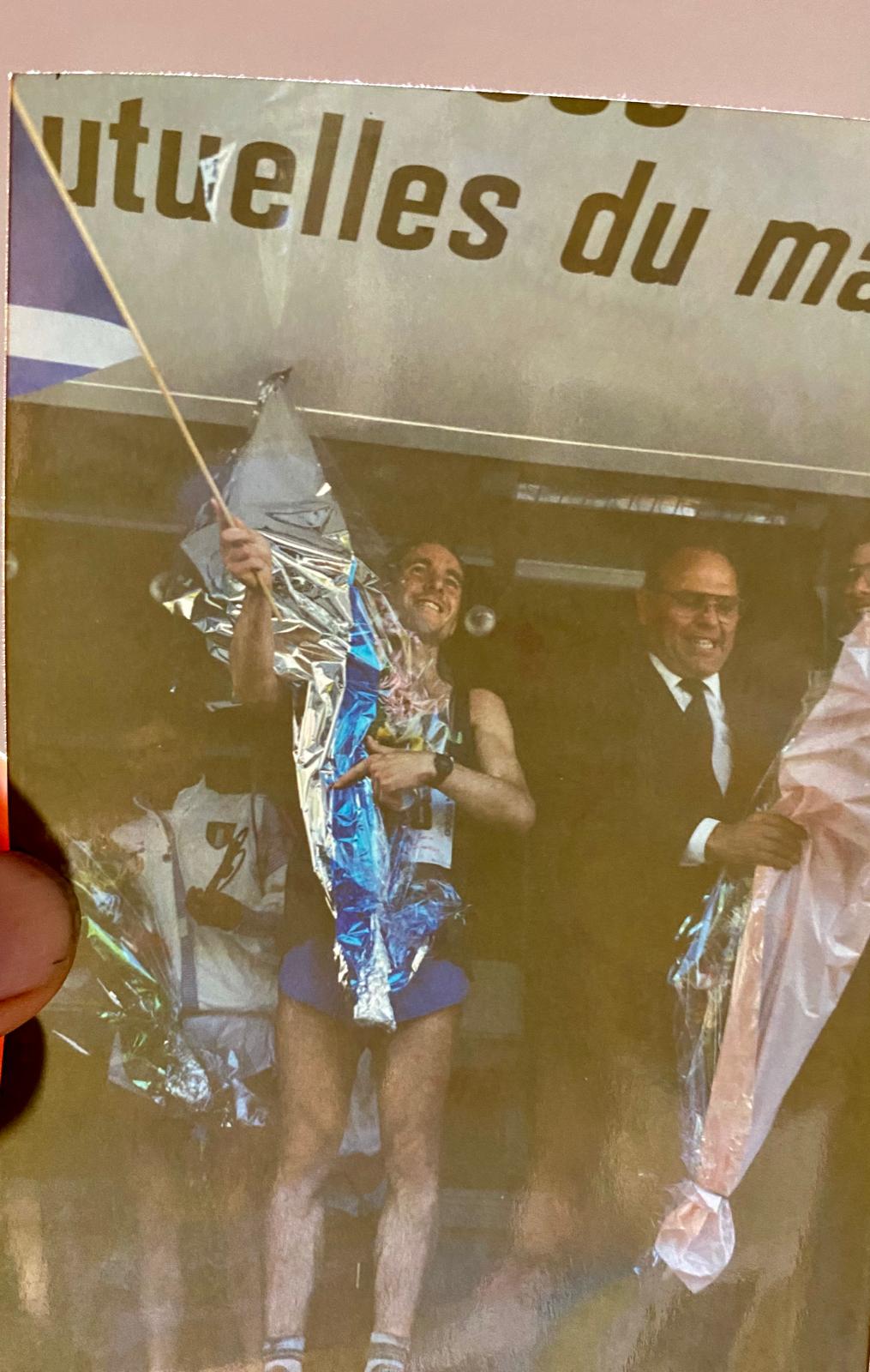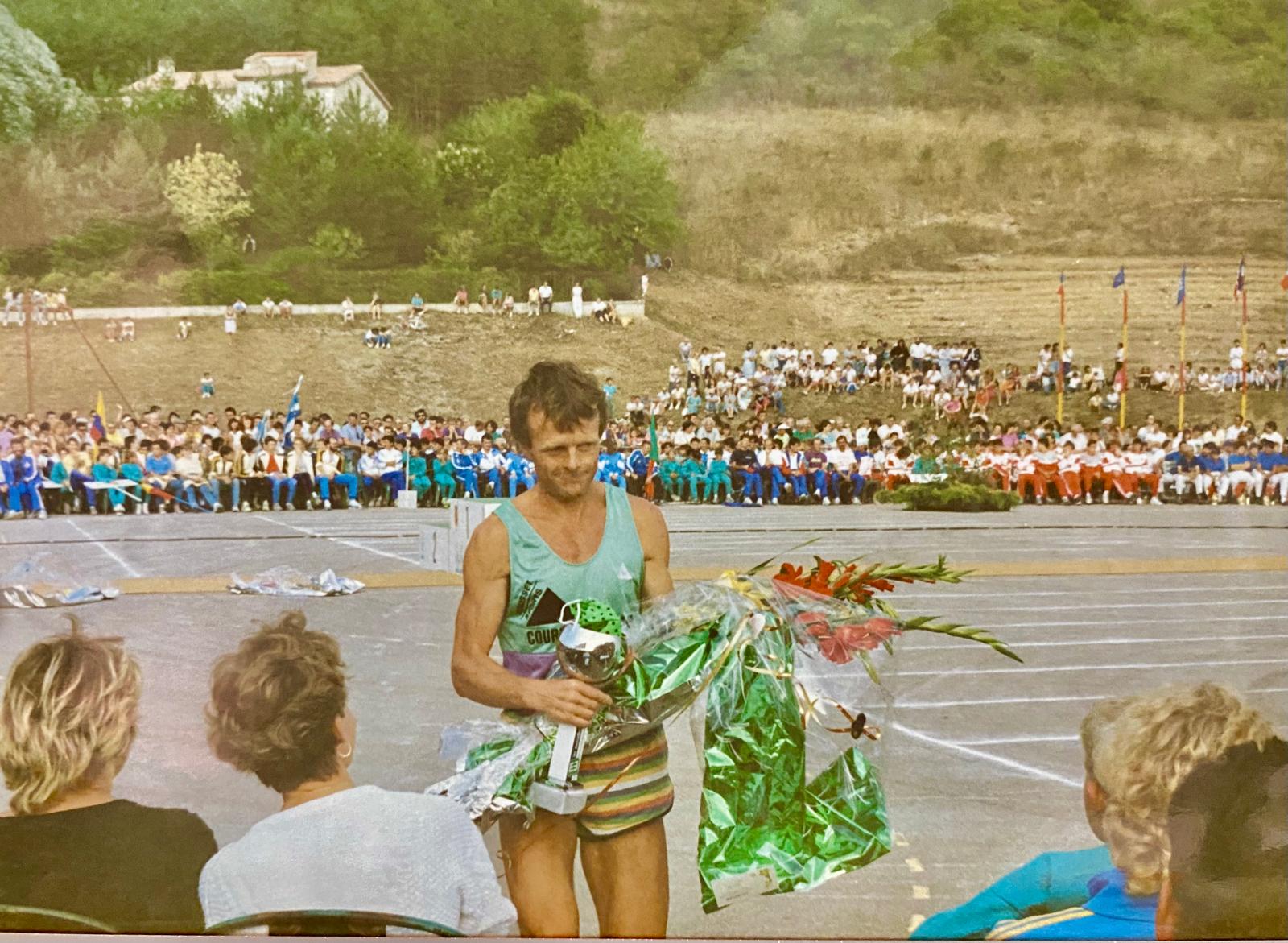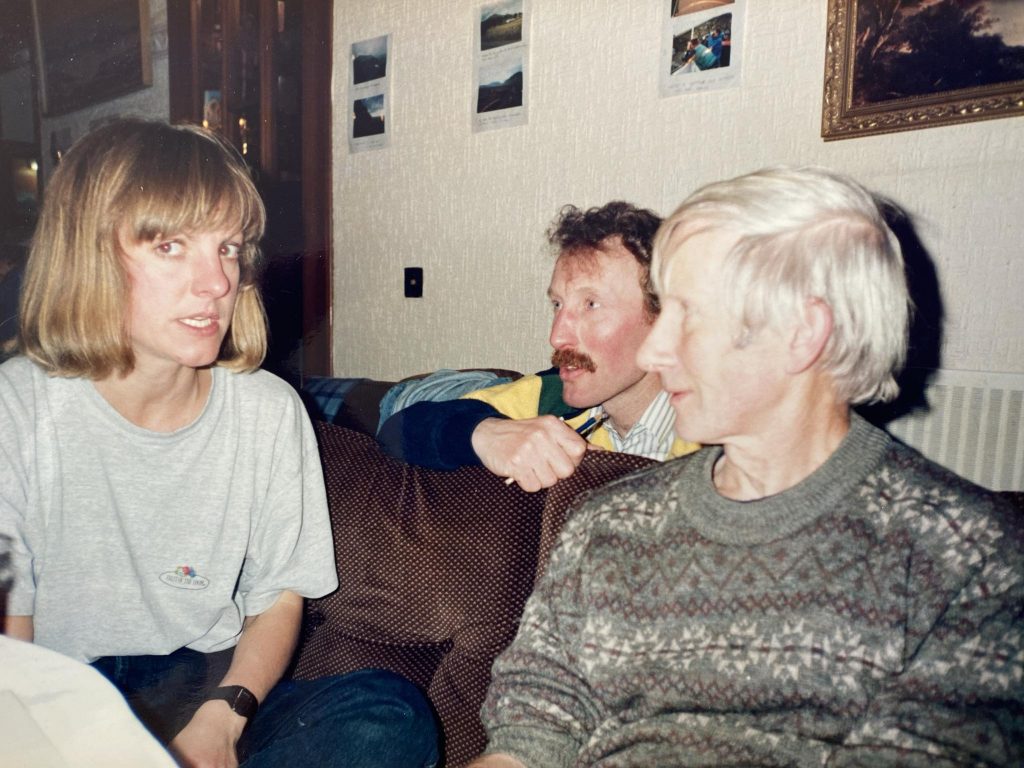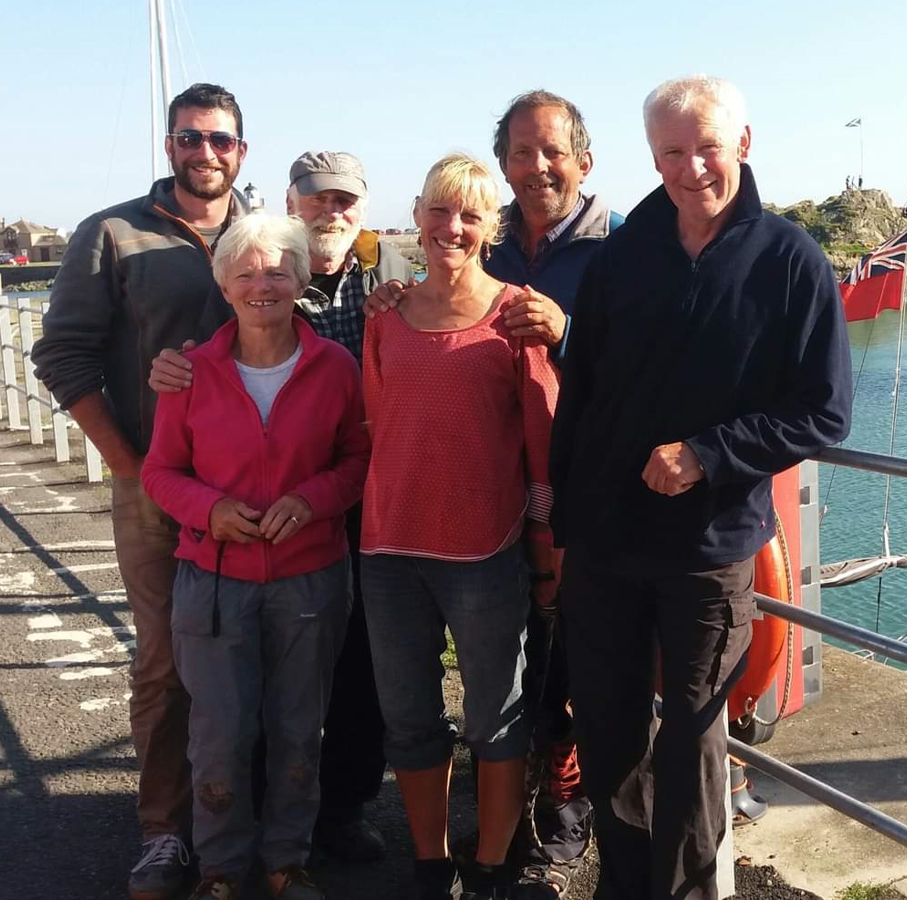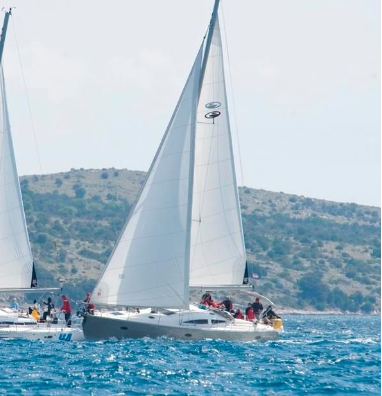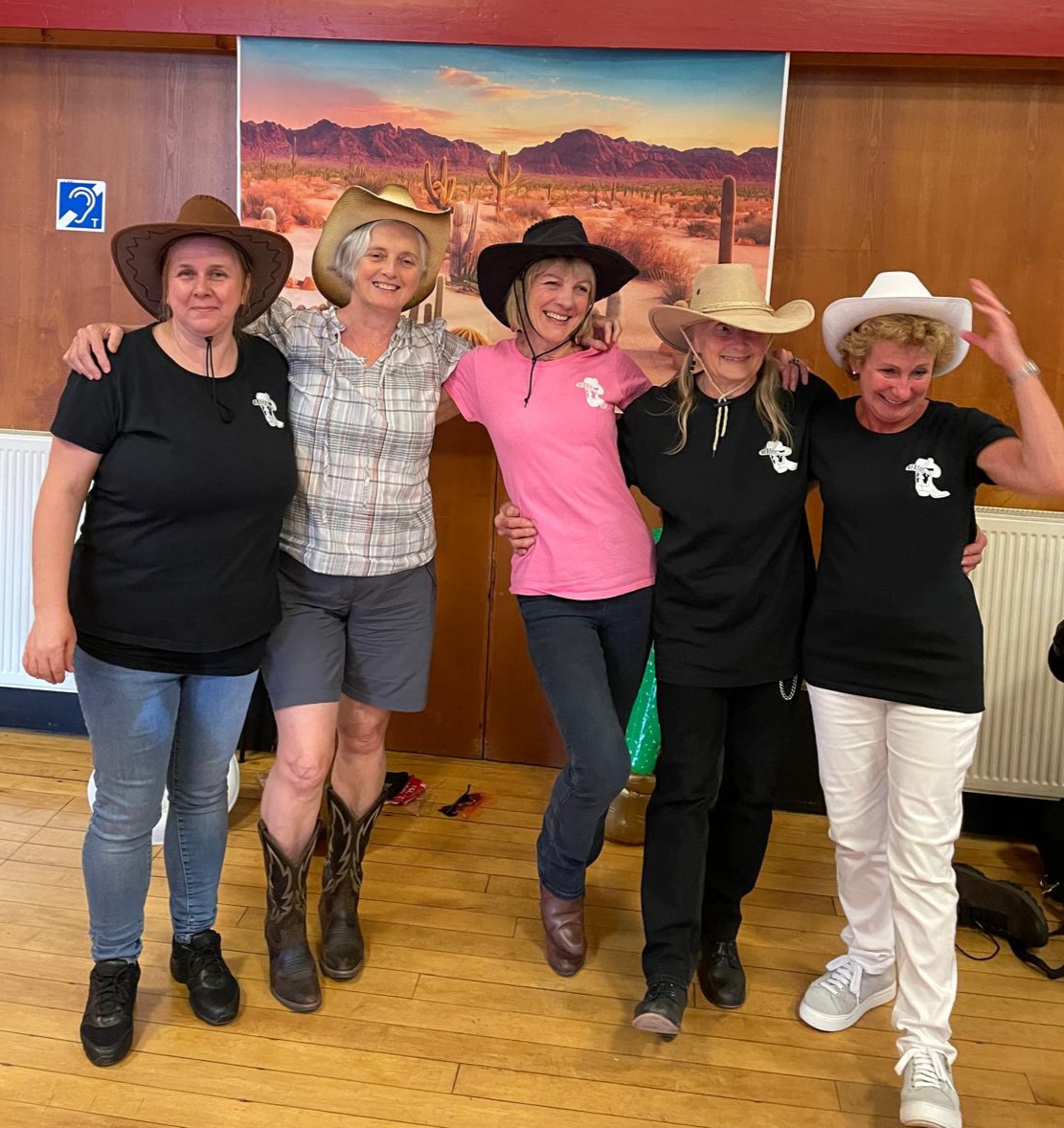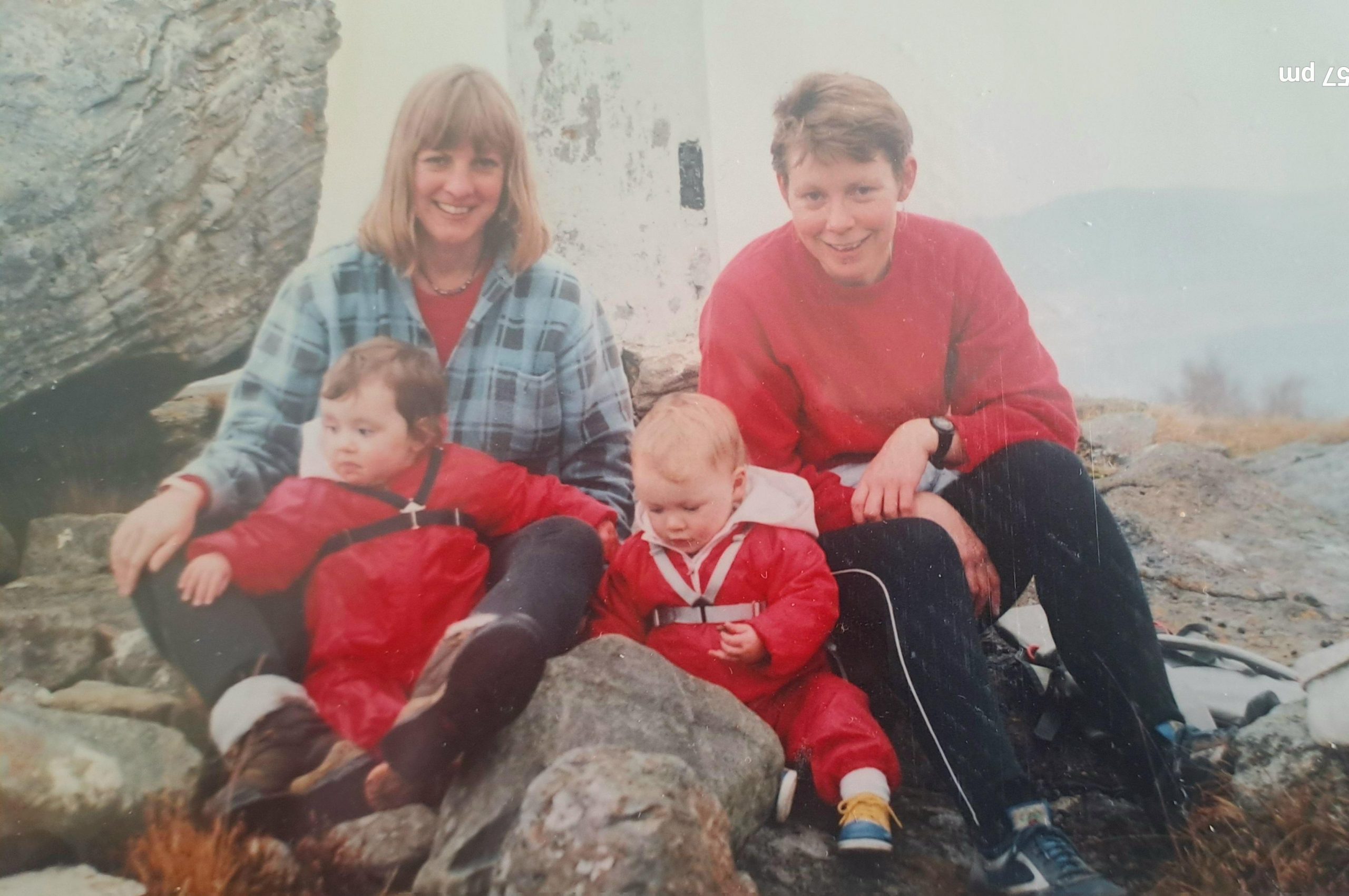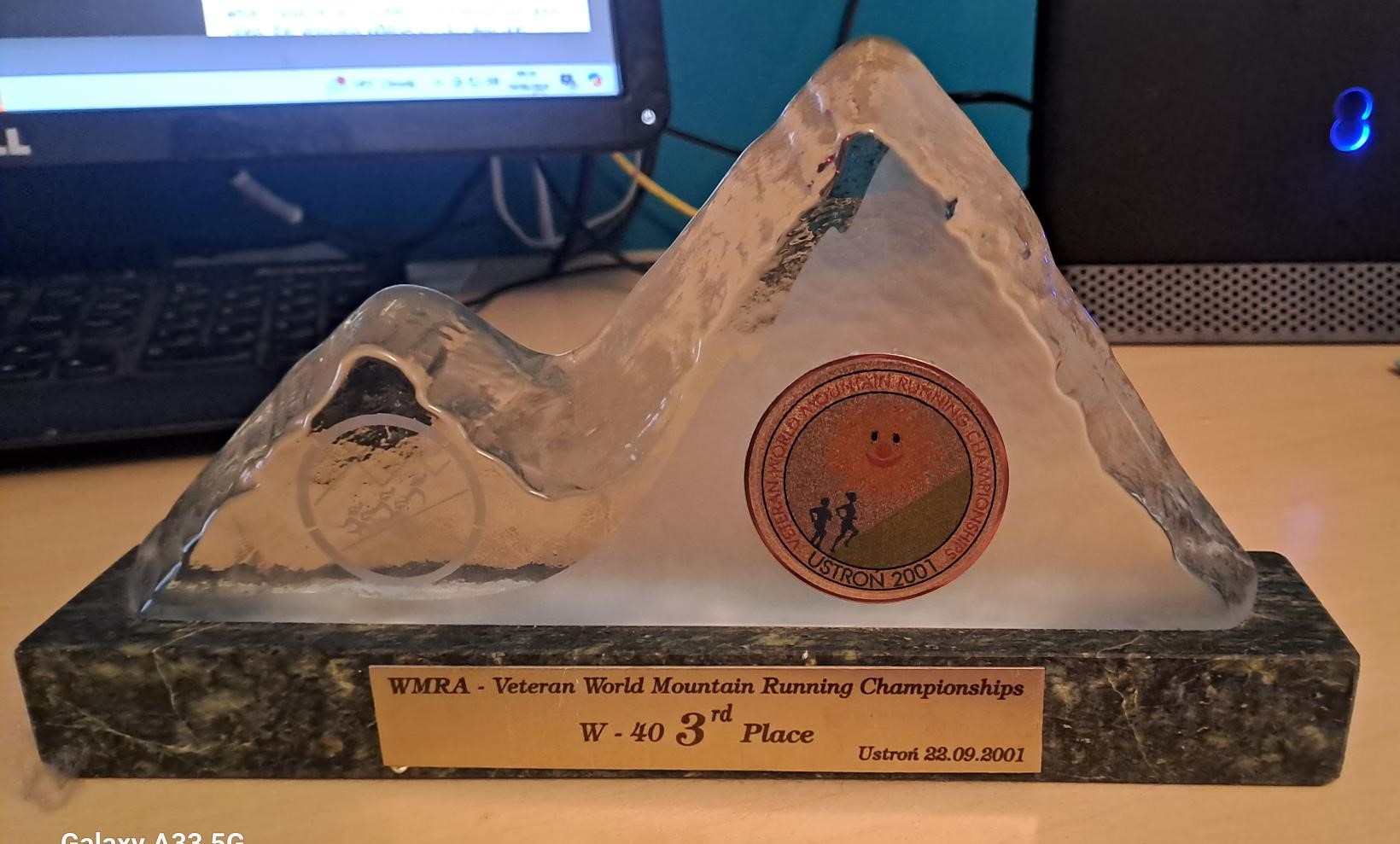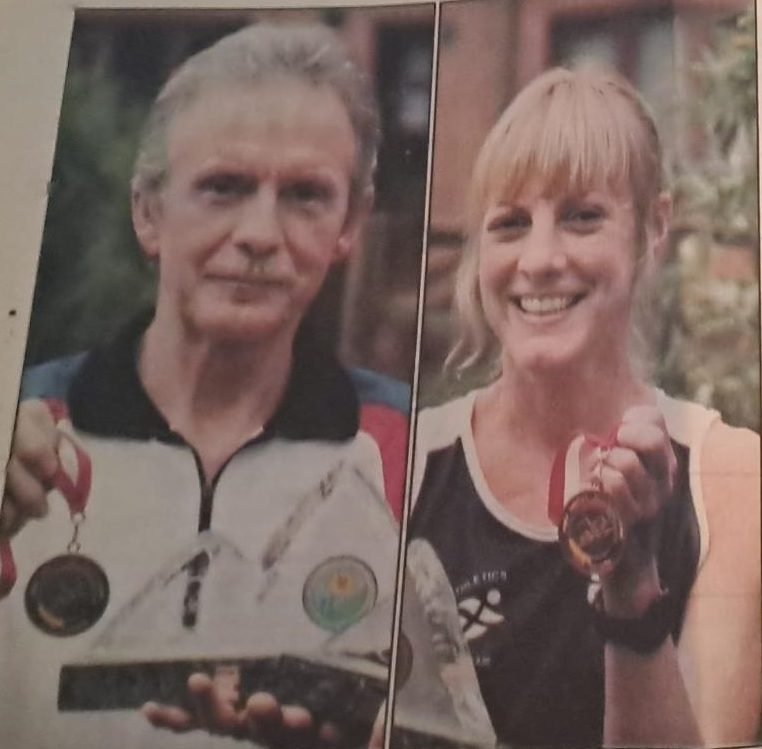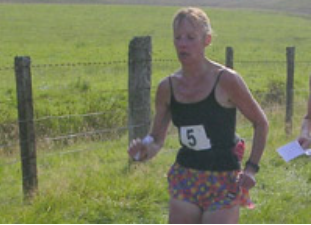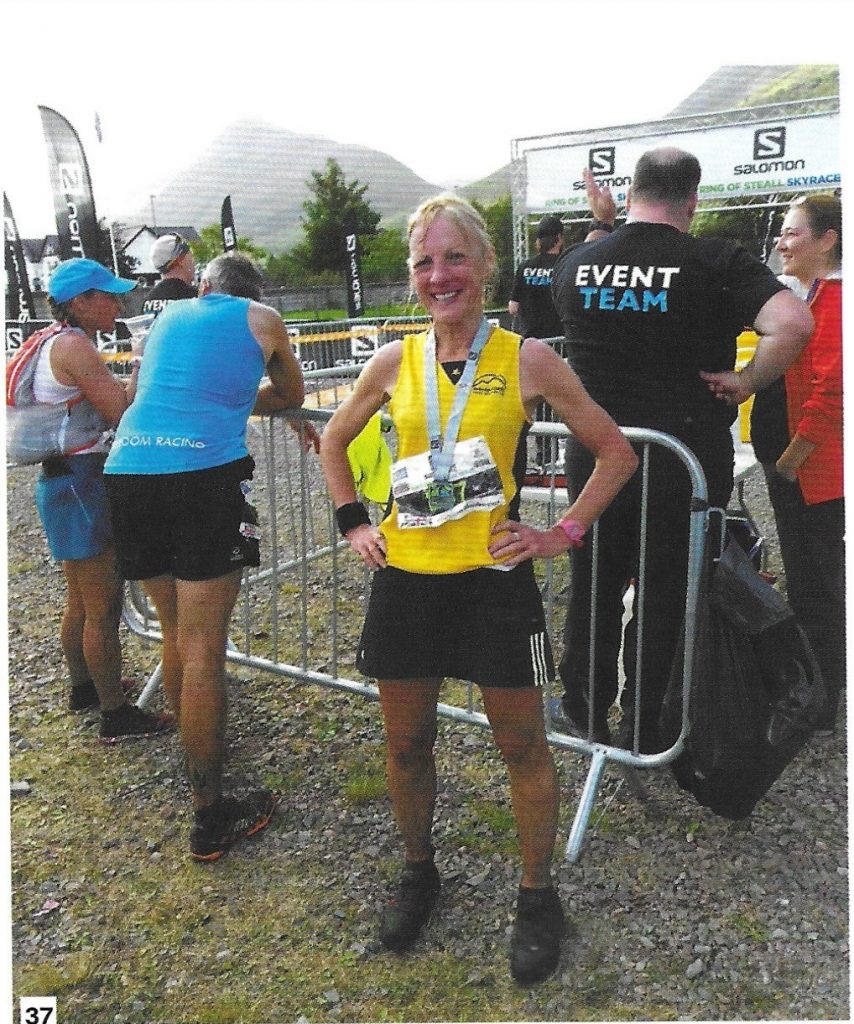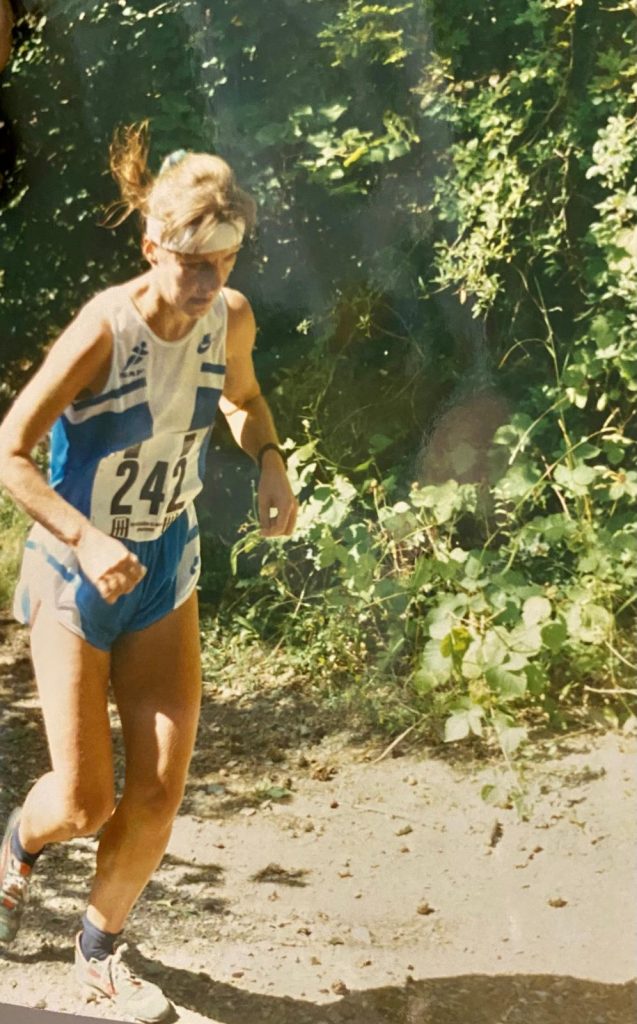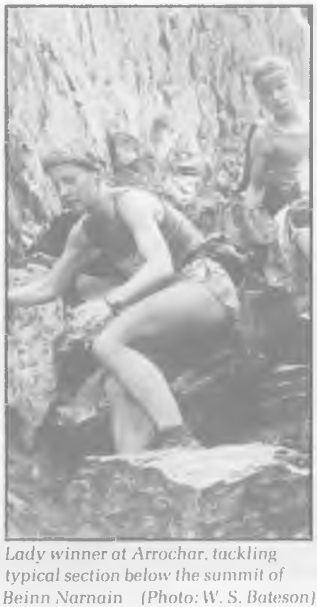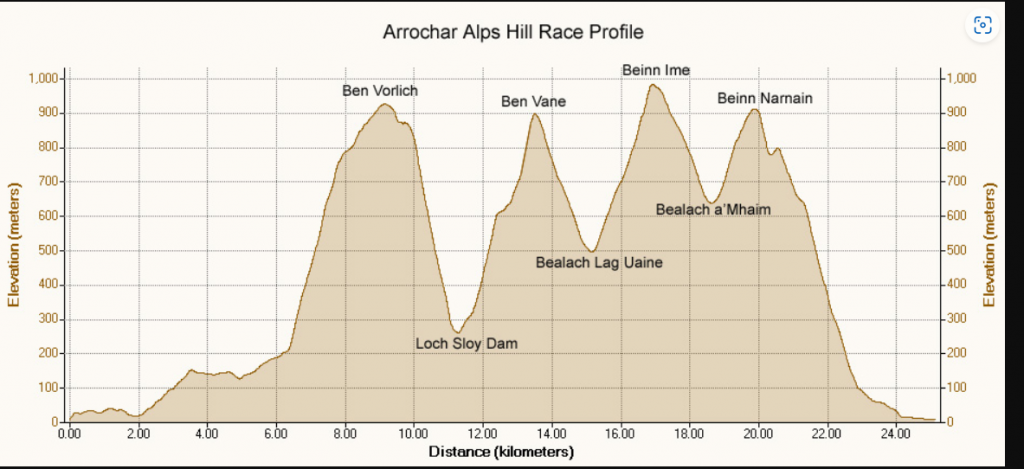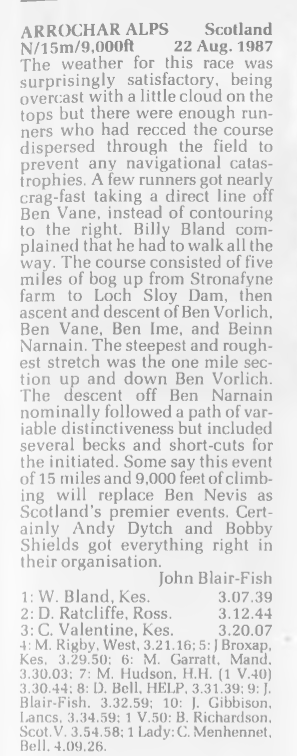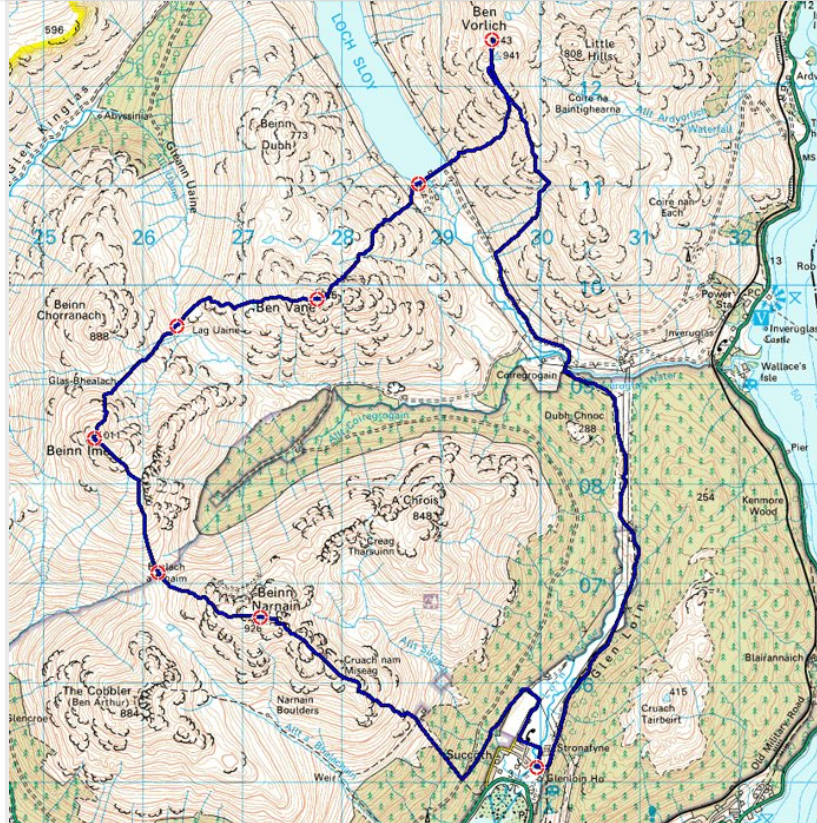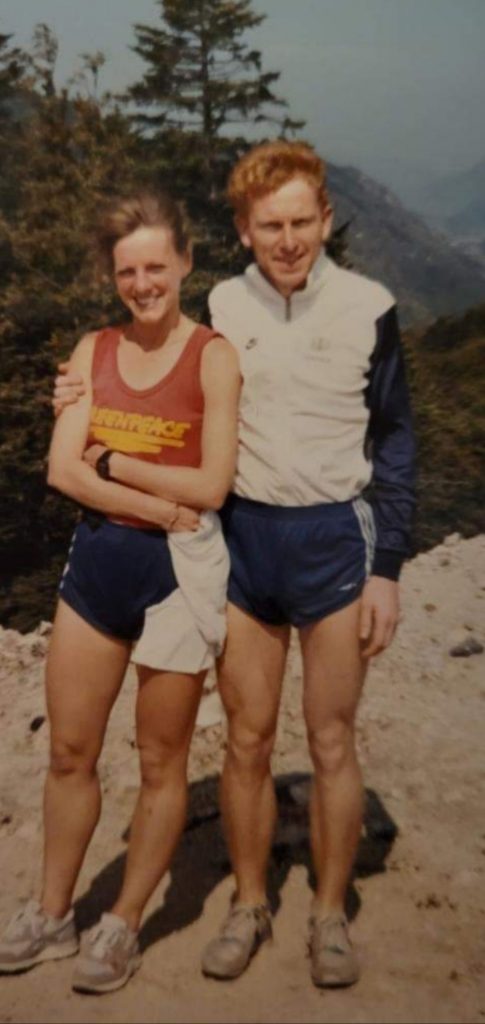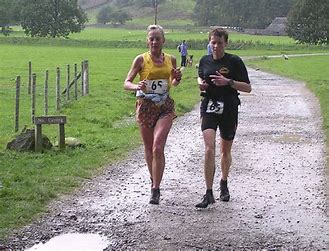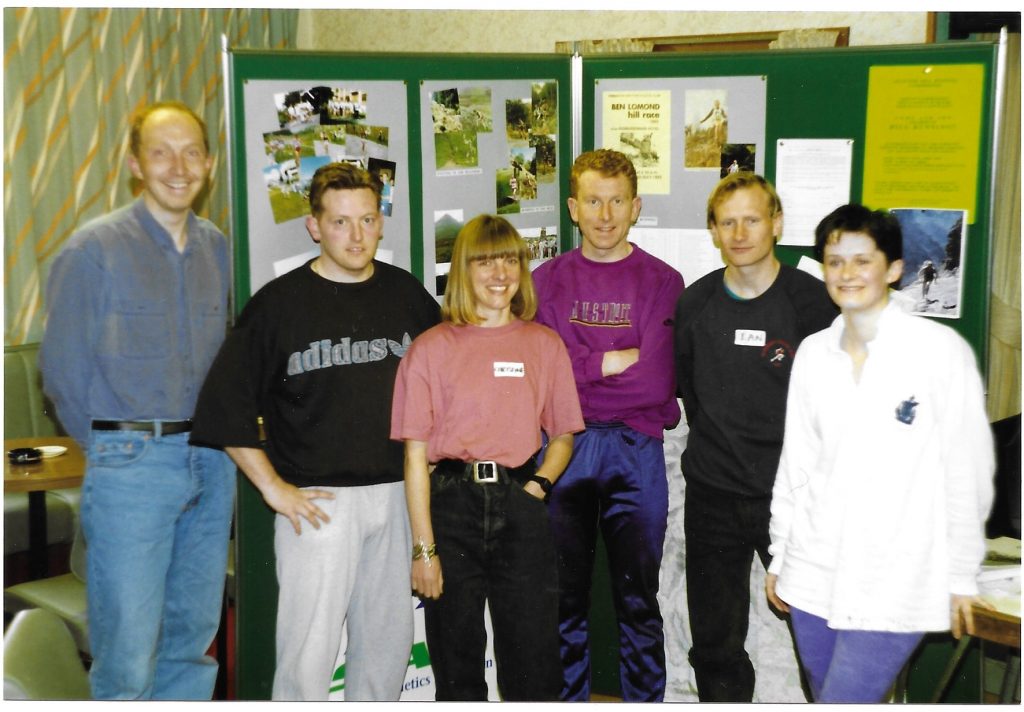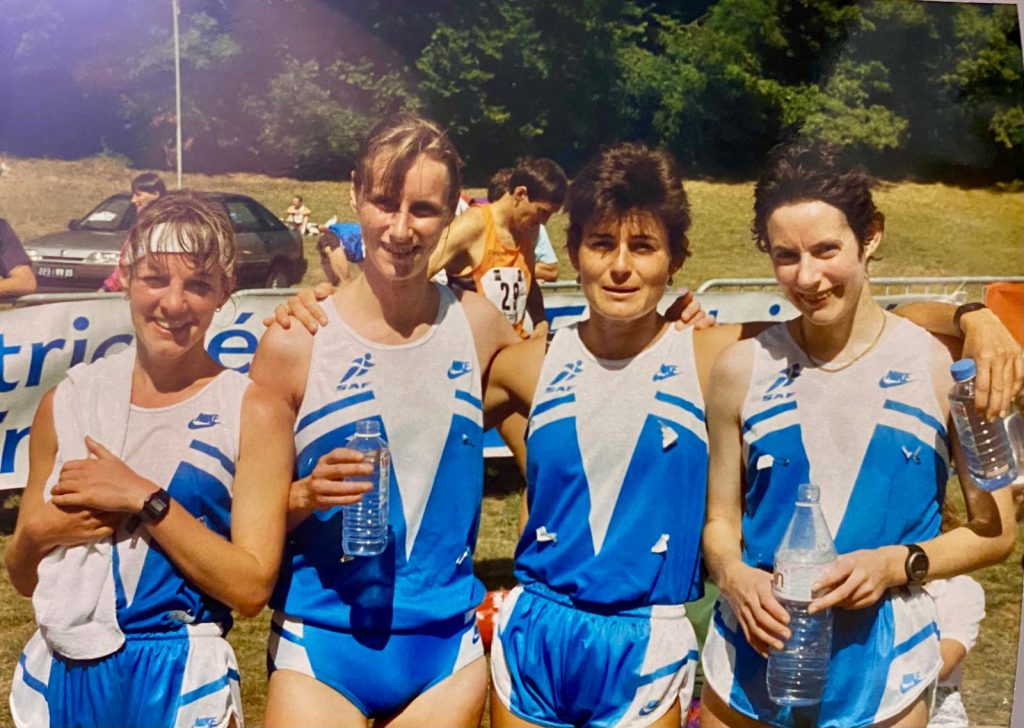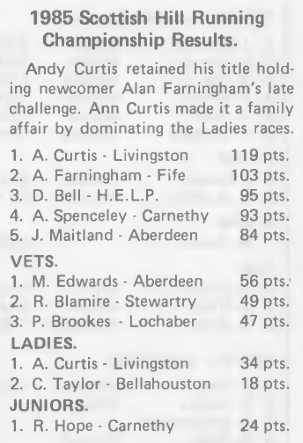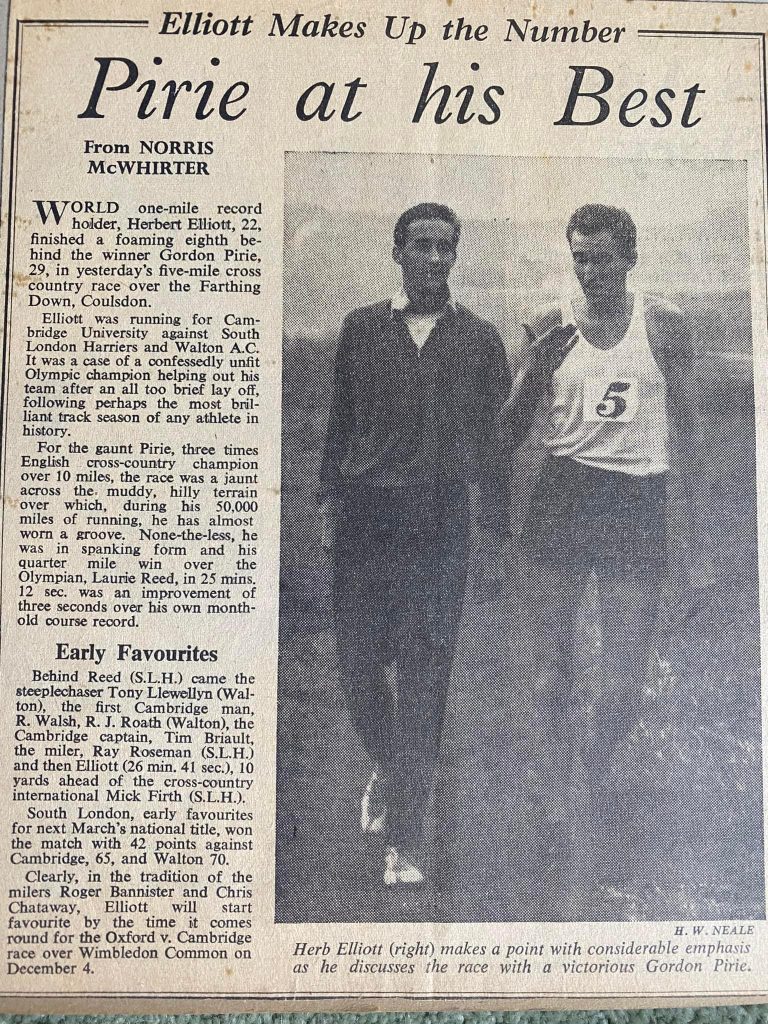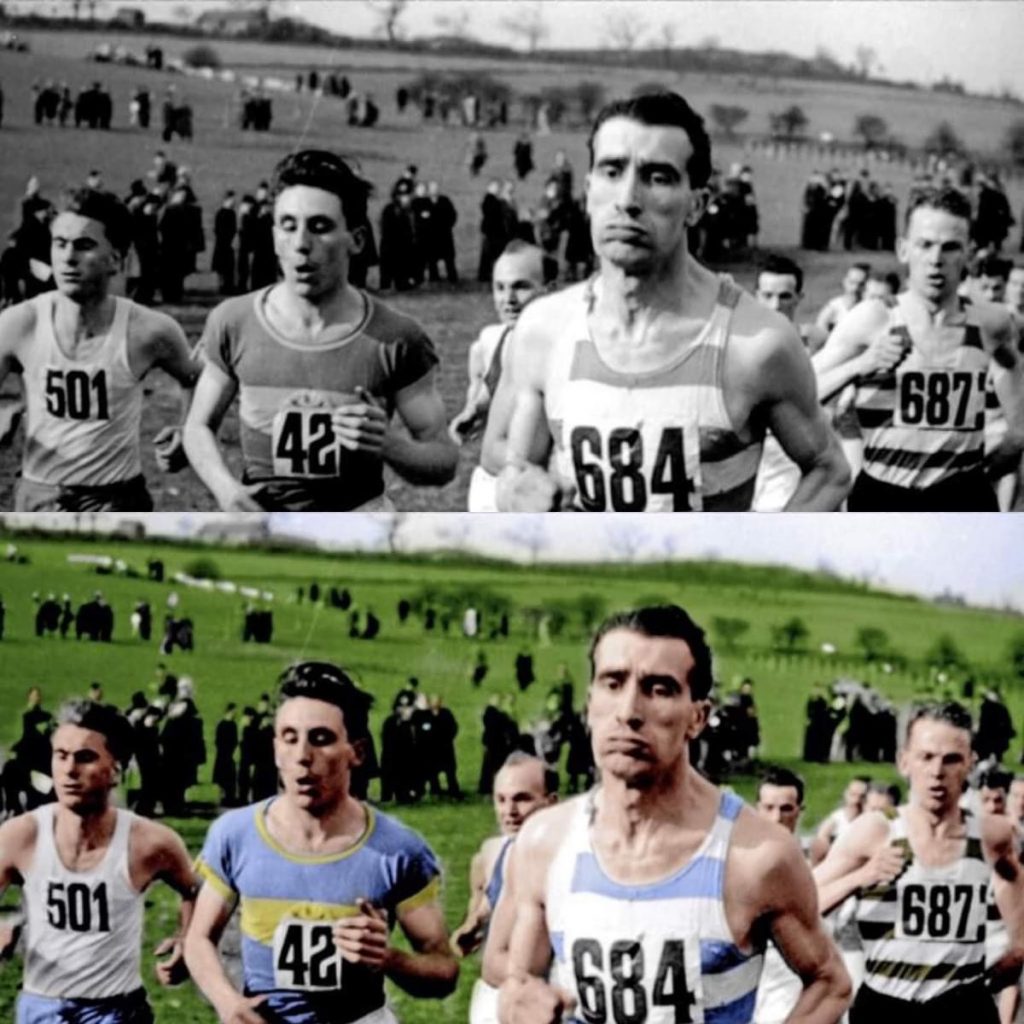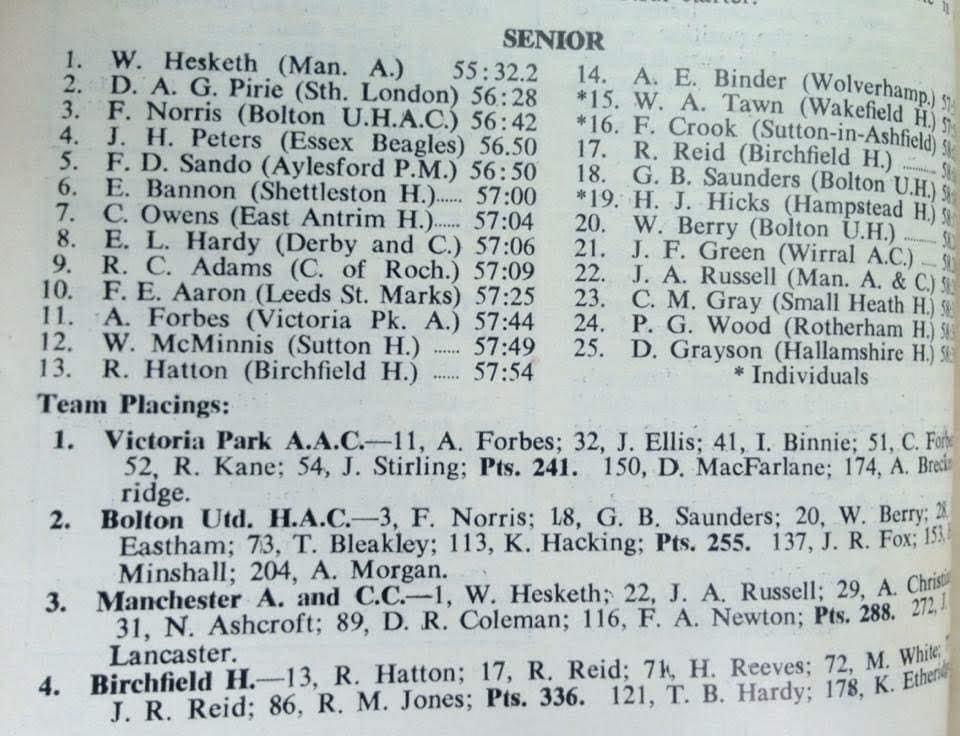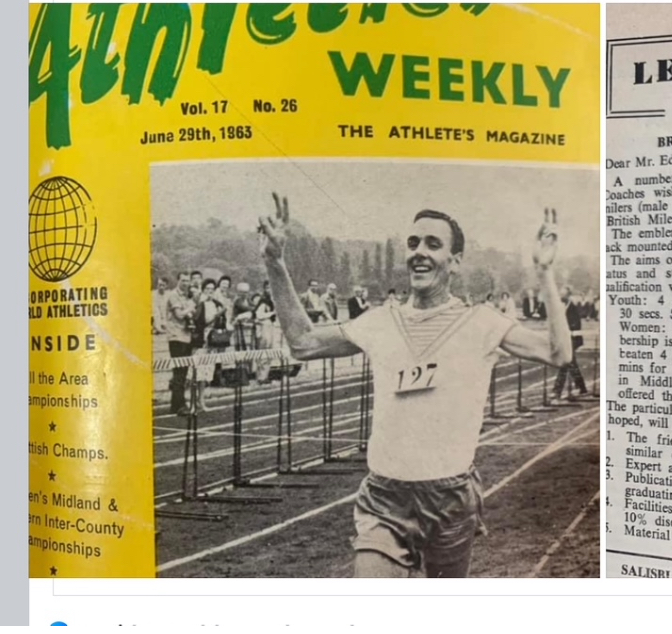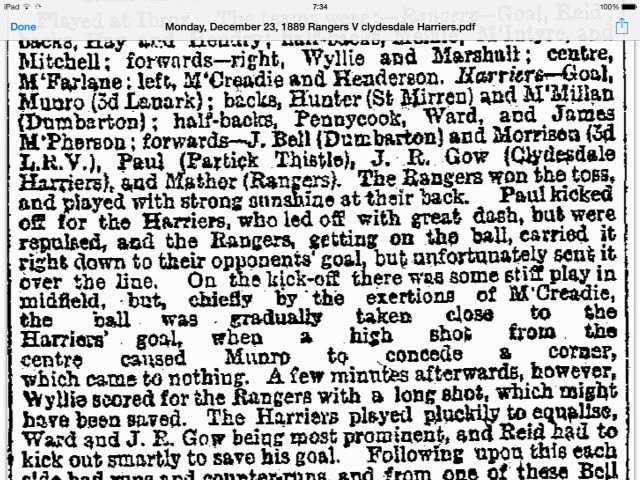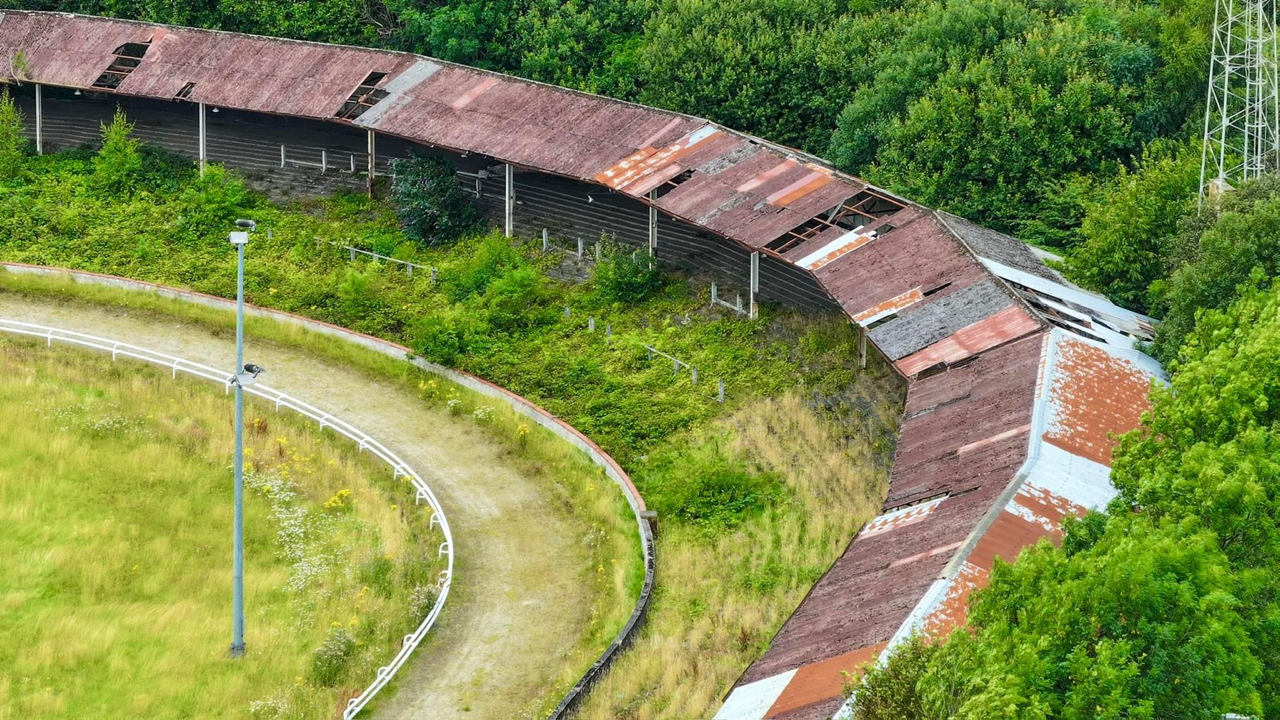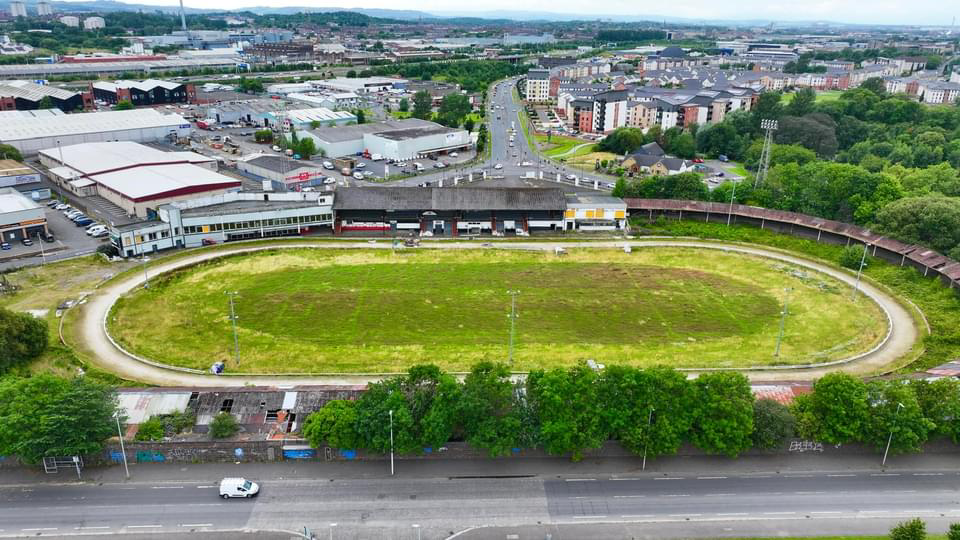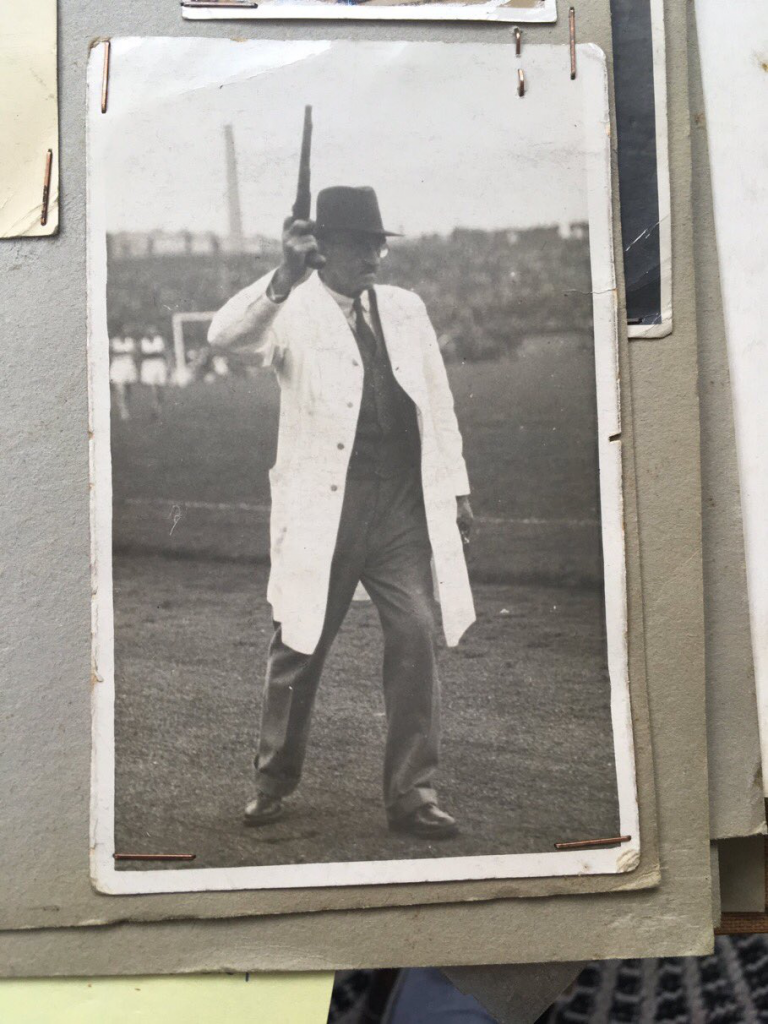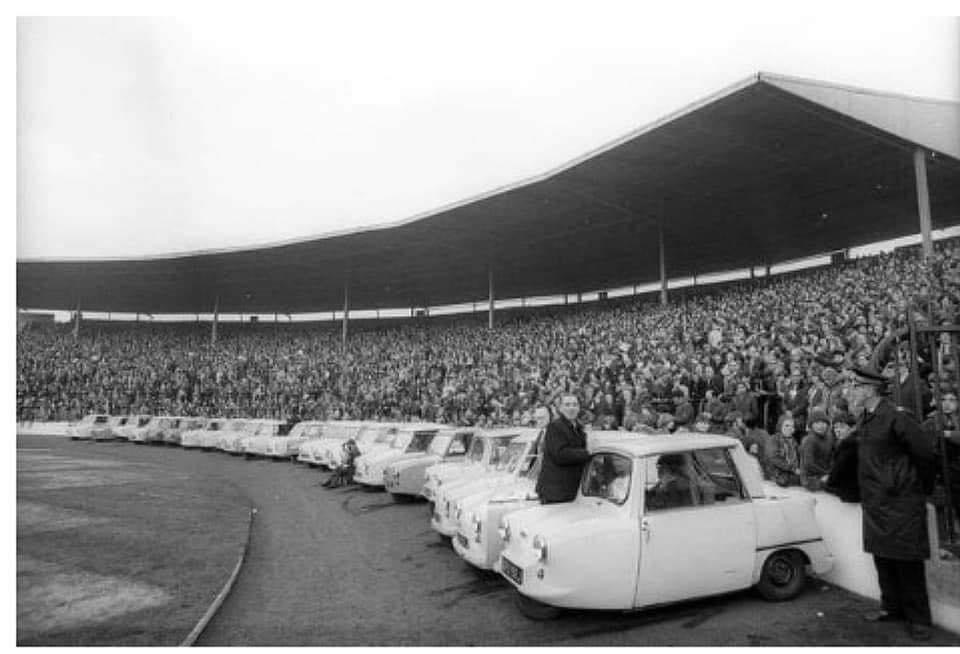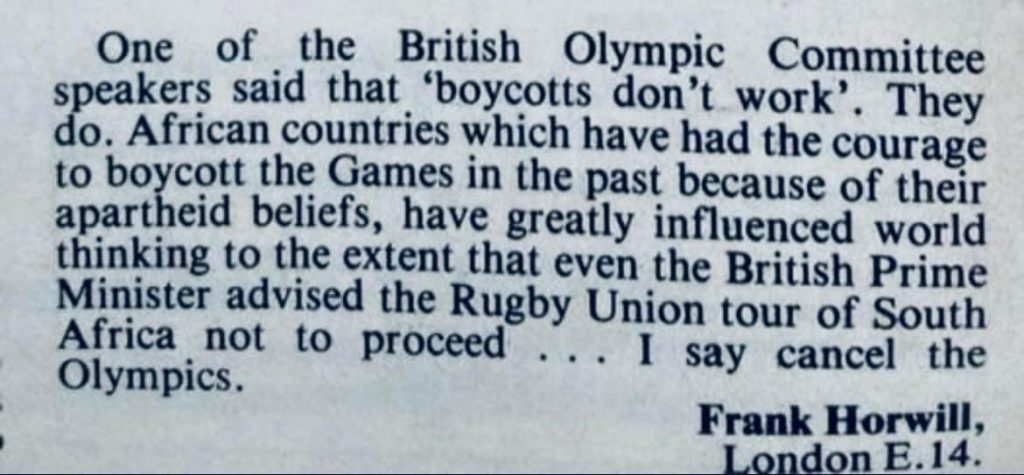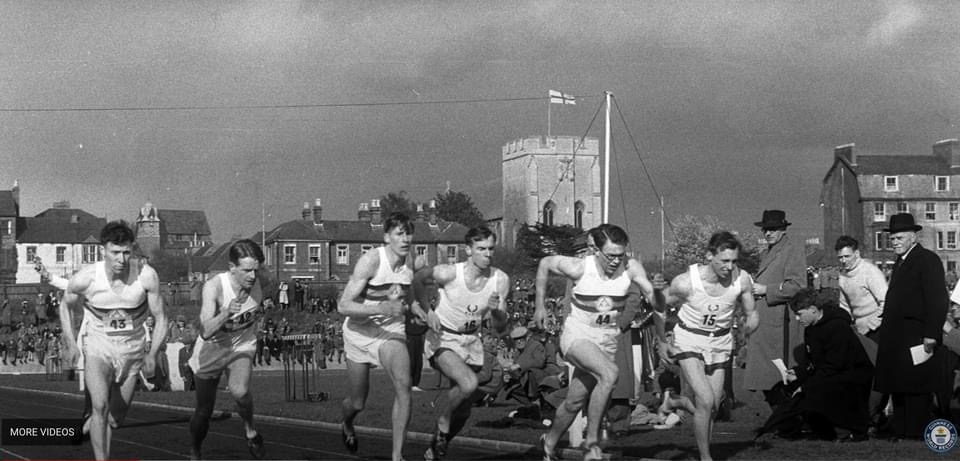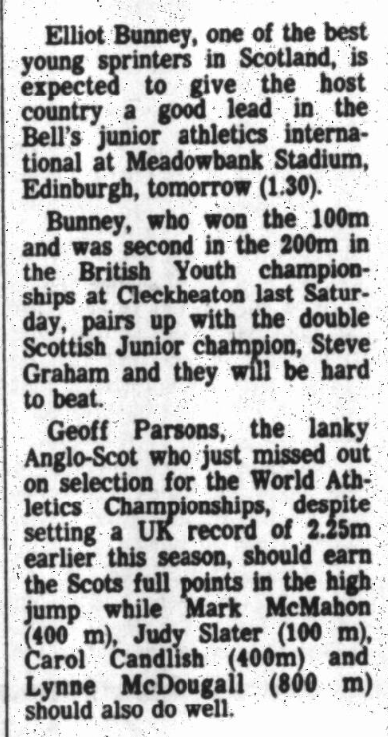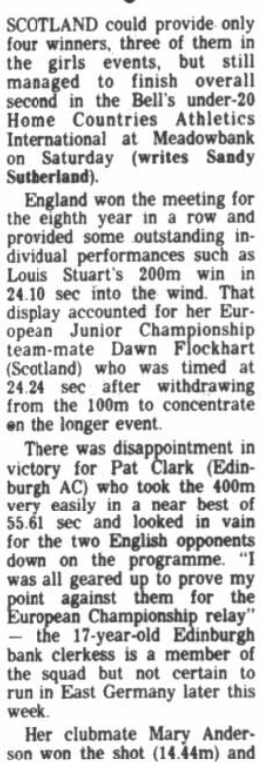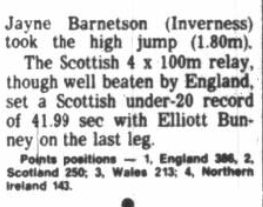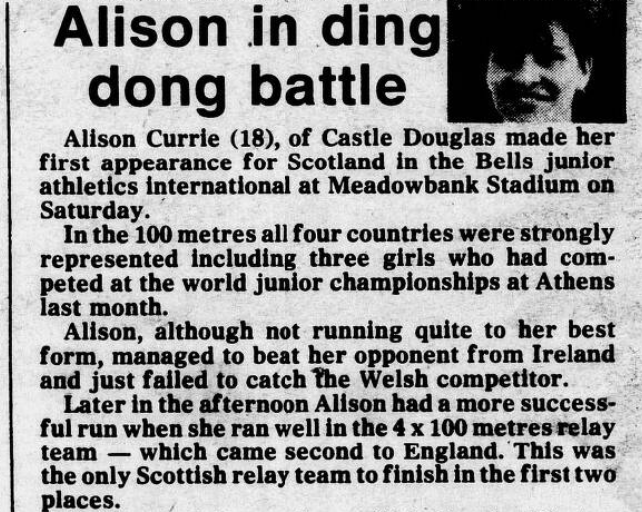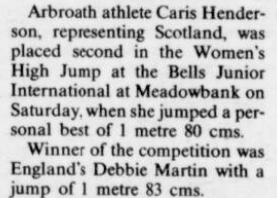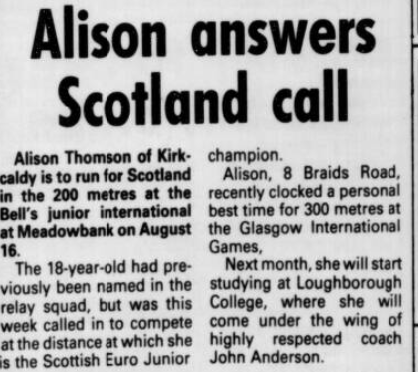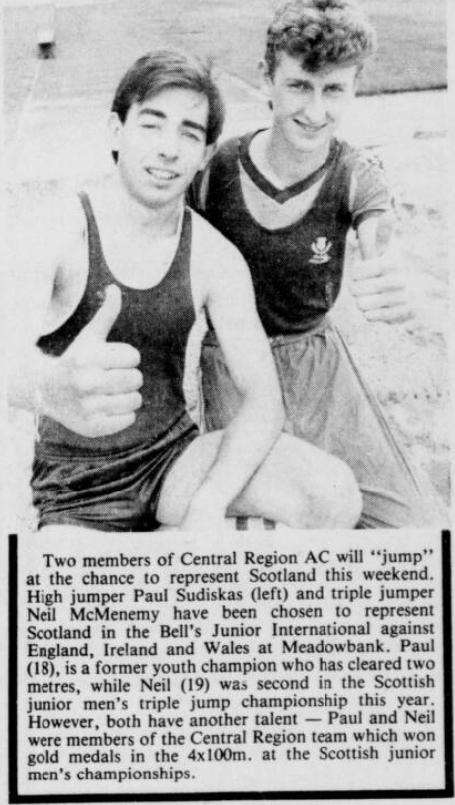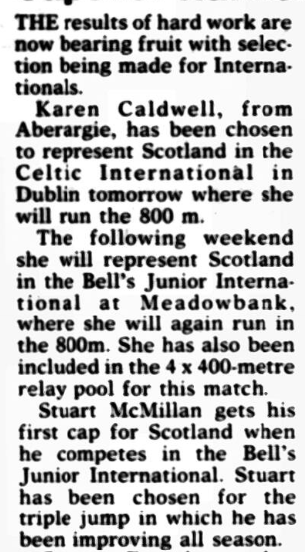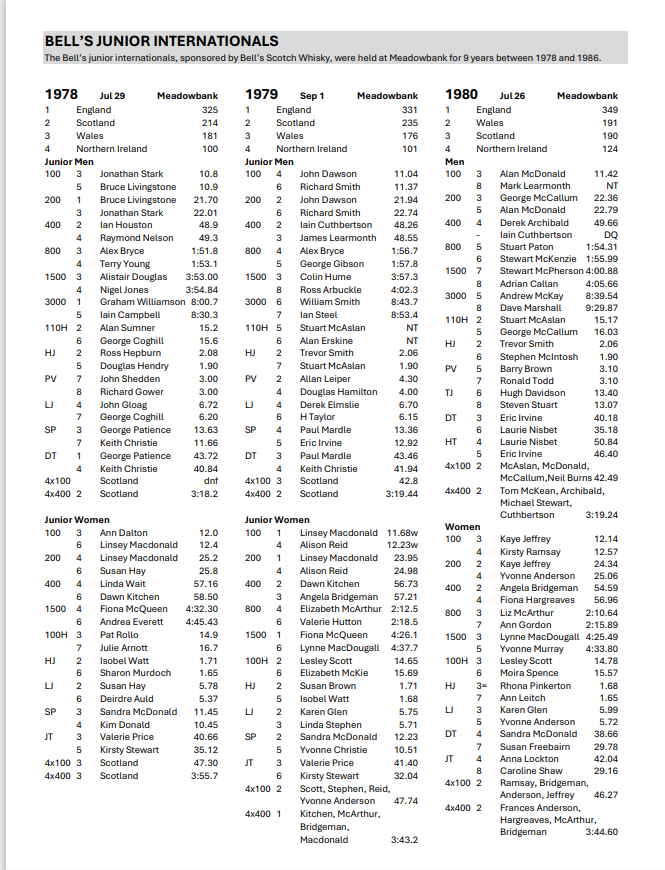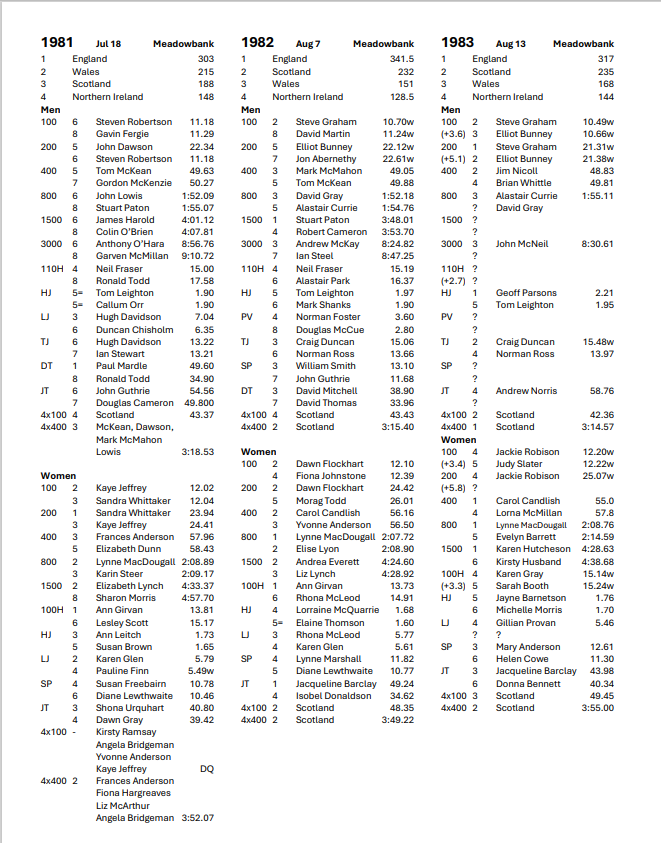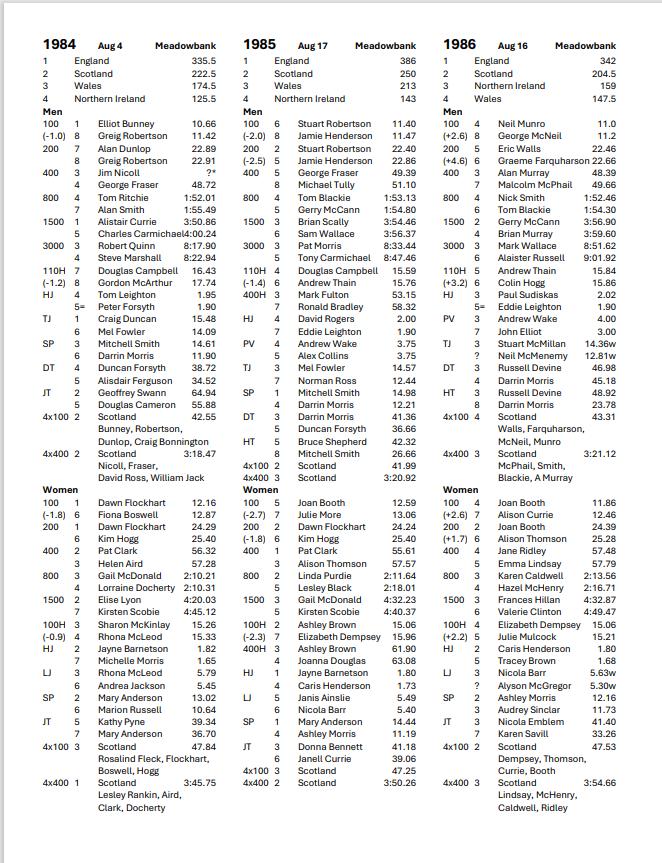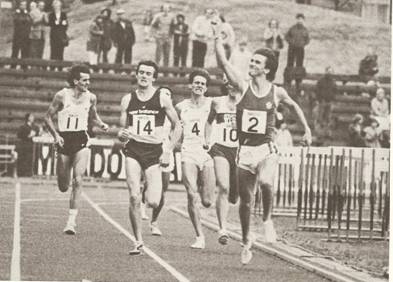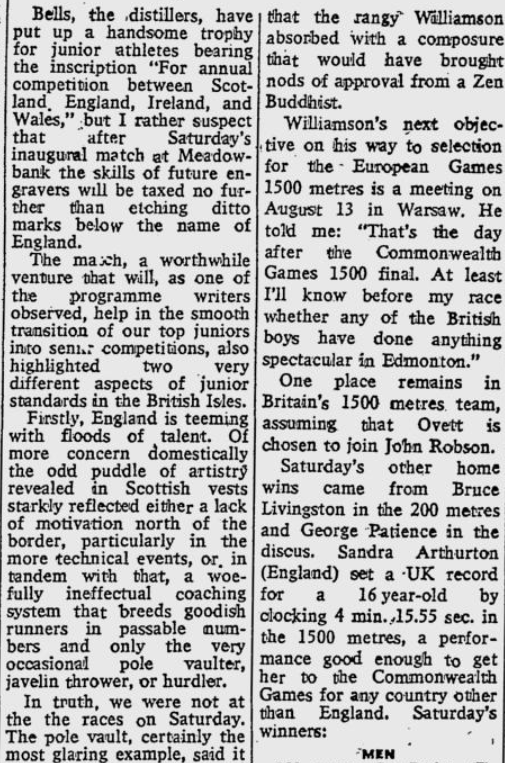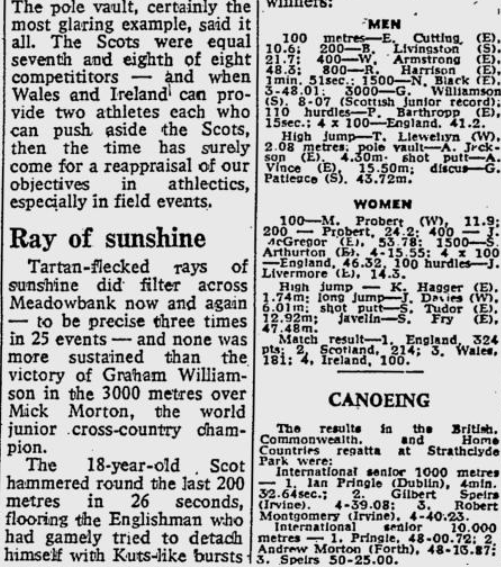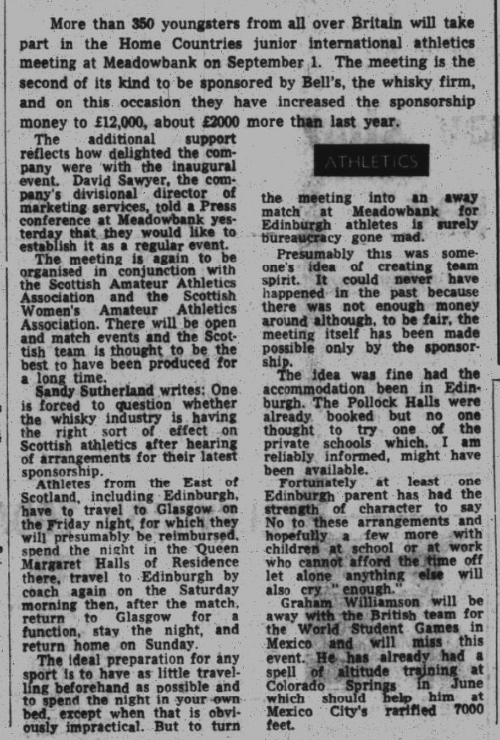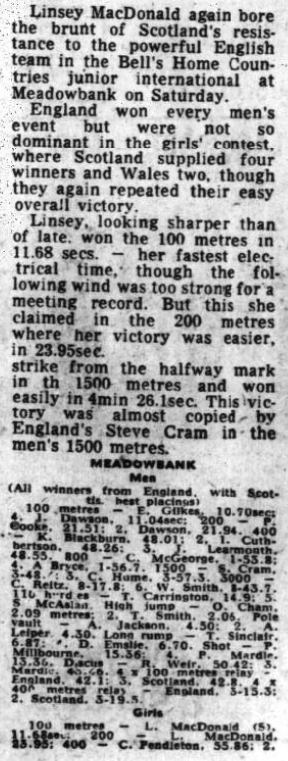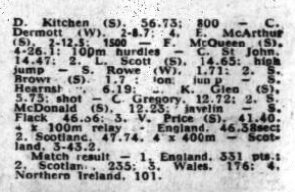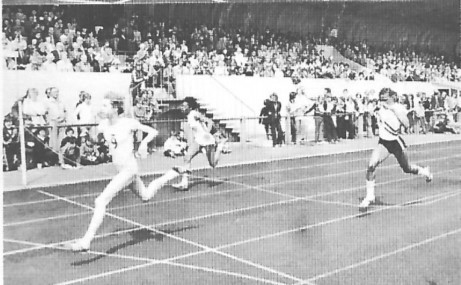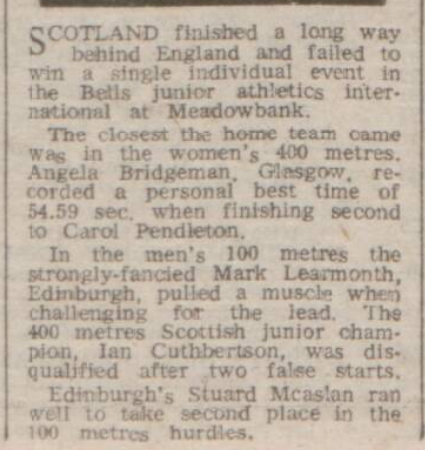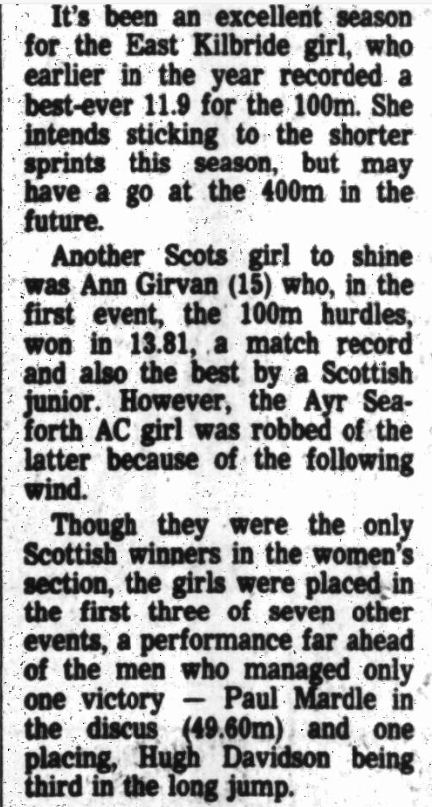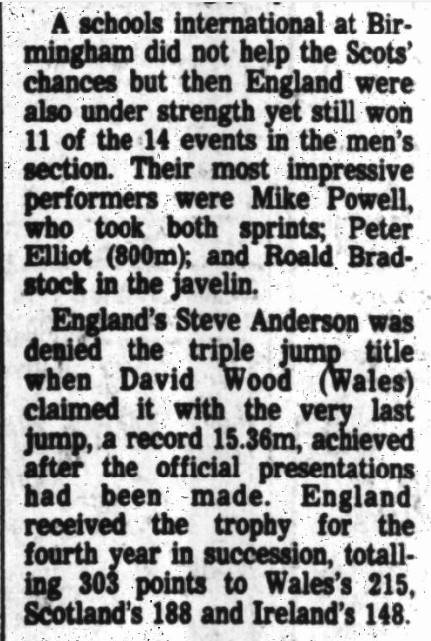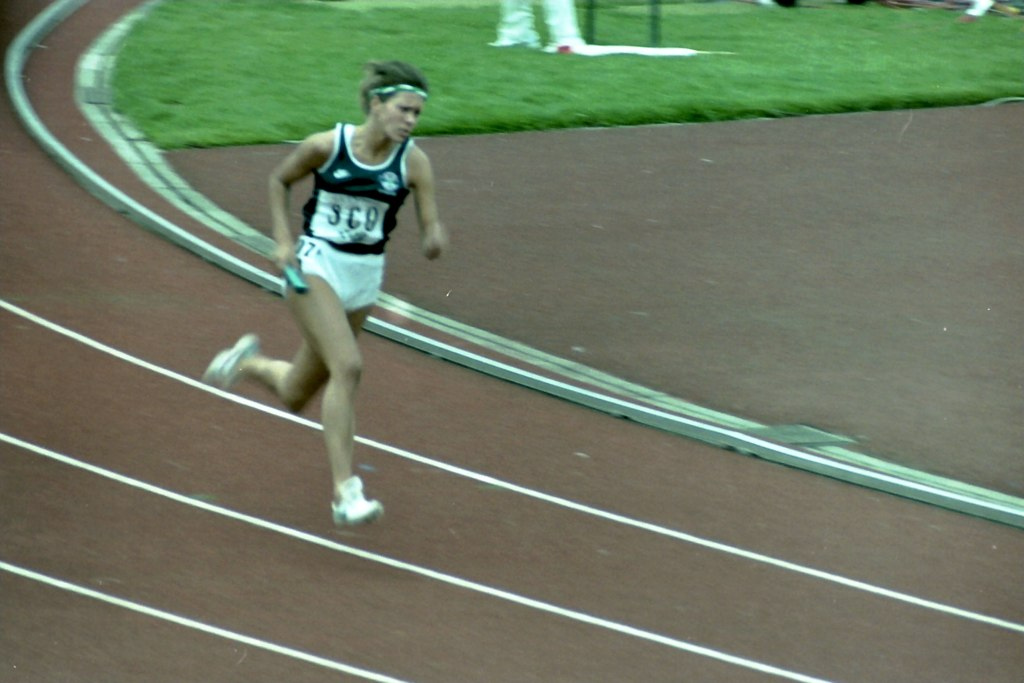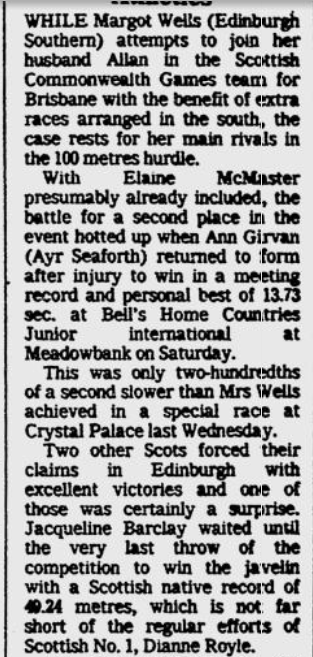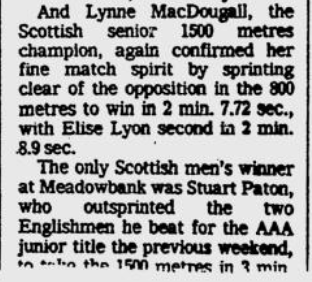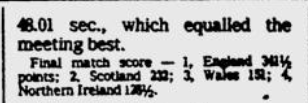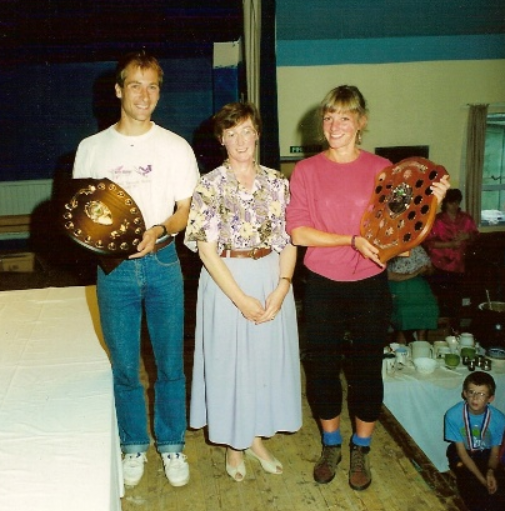
Christine after winning the Great Wilderness Challenge in 1991
25 mile race winners Martin Dean, Forth Valley Orienteers and Christine Menhennet, Westerlands CCC, receive their shields from guest-of-honour Joyce Mackenzie, Gairloch
The 1990’s was a good decade for Christine with a high level of performance coupled with many serious challenges met. She bracketed the decade with victories in the Great Wilderness Challenge in 1991 and 1999, Island Peaks Races contested in both Scotland and Australia, international races in Snowdon and Susa in Italy and triumphs in such events as Stuc a Chroin, the Corrieyarrick Pass and the Ben Lomond race. There were so many races that we can’t cover them all but we can pick out some of the more significant ones.
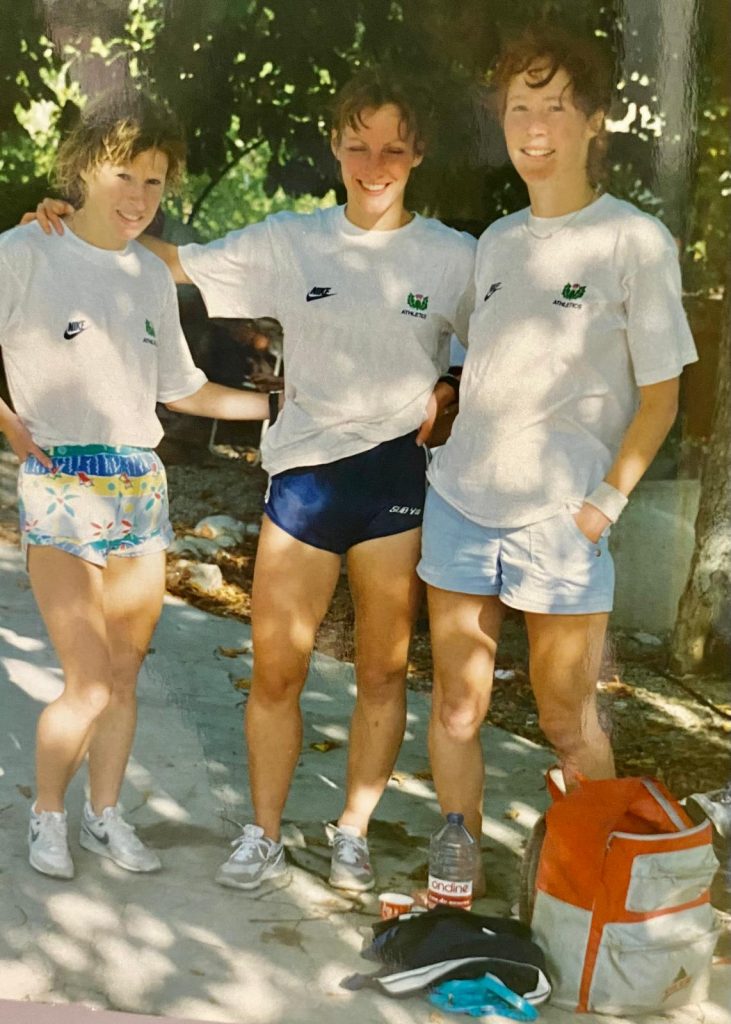
Christine (centre) with Scottish international team mates Joyce Salvona and Christine Whalley at Die in 1989.
1990 was a good year for Christine in that she ran in two Island Peaks races which are approximately 12,000 miles apart! She ran well in both the Scottish Island Peaks race and the Tasman Island Peaks race in Australia. Sponsorship helped, being able to do a reconnaissance in the Tasmanian one before the race and so on all helped but the toll taken on the body was huge. She had been organised to run both with Helene Diamantides but she (Helene) had picked up an injury after the first one and was unable to do the second but Christine and her new partner still turned in the fourth fastest running time of the 23 teams entered. You can read some detail about these races at the Scottish Island Peaks Races page.
Among the major races in 1991 were the two races on the Island of Arran. In 1991, she was back racing starting with the two races in Arran. Goatfell was on 18th May and she was second to Joyce Salvona in 1:35:53, and a month later on 15th June she finished second in the Glen Rosa Hill Race in 3:13:06 behind L Hope (2:56:31). Map below of the Glen Rosa course is from the Scottish Hill Racing website. On 9th November that year she was again second, this time in 39:03, with M Todd of Edinburgh University in 38:05.
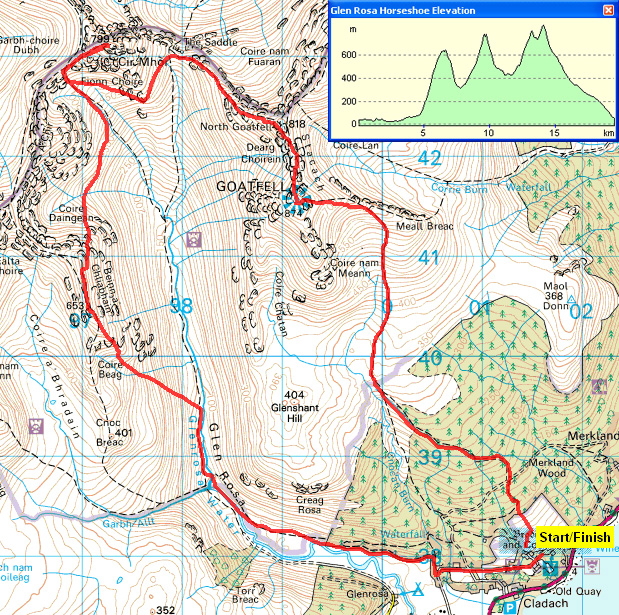
The really big event for Christine however was the Great Wilderness Challenge. Like many of the hill races or challenges it started as a purely local event. The official history of the beginnings is as follows.
In early 1986, plans were afoot to provide hospice care in the Highlands for the first time. The Highland Hospice Appeal was set in motion to raise funds for the project, and a Highland-wide campaign was launched in support of this initiative. A small group of friends in Poolewe and Aultbea, some of whom had recently lost relatives to cancer, decided to do something to help. A sponsored walk was the vehicle chosen to raise funds, and arrangements were quickly made to organise what would become known as the Great Wilderness Challenge. The first staging of the event took place on Saturday 23rd August 1986. It featured 178 walkers and runners undertaking the arduous 25 mile mountain trek from Dundonnell to Poolewe. It passed off very successfully, and £6,200 in sponsorship was raised for the Highland Hospice Appeal. The event was originally intended as a “one-off”, but such was the popularity and success of the first that participants – and marshals! – clamoured for a repeat. So the GWC was destined to become an annual event and has been held every year since 1986.
This was the race for which Christine headed north in August 1991. There were 57 finishers with Christine in 23rd place in a time of 3 hours 46 minutes 19 seconds to be first Lady, with Lesley Hope of Lochaber AC in 4:02:37 second Lady and 30th overall.
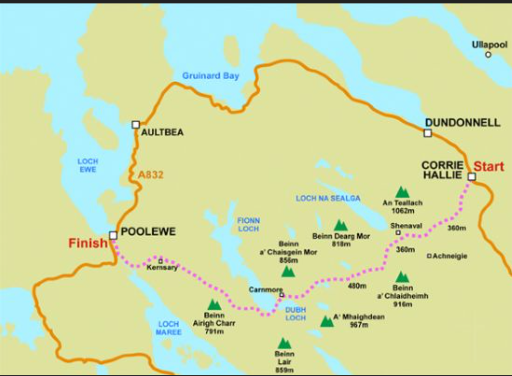
Map from the Race website.
1992 was another good year for Christine with success at home and abroad. She was selected the International World Mountain Running Championship in Val di Susa in Italy on 30th August, and followed the selection with a very good race in Scotland. They were described in the ‘Clydebank Post’ thus: “Having raced well in the Snowdon International, Clydesdale Harrier Christine Menhennet learned on Thursday that she had been picked for the World Hill Running Championships at Susa, Italy, later this month. Inspired by this success she travelled to the Glen Trool Forest Hill Race on Sunday where she not only won but broke the course record by a full eight minutes when recording a time of 1:36:37. Christine was the first Lady to finish and seventh runner overall.”
The International Snowdon Race referred to above was held on 25th July in 1992, was over 10 miles with a total ascent of 3200 feet. Christine finished fourth (second Scot) in a time of 1:23:27 with the race being won by Scotland’s Trish Calder in 1:18:37. The result for the International in Susa has been taken from The Fell Runner magazine for October 1992.
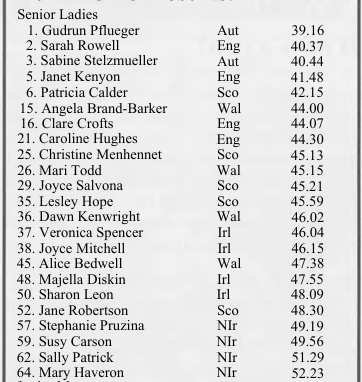
Other than the internationals, her record for 1992 includes the following results: (note the fast time for the Corrieyairrack which saw her finish 12 minutes clear of the second runner, and the two races which were timed outside 2 hours and another over an hour).
| Date |
Event |
Time |
Position |
Comment |
|---|
| 15 Feb |
Tiso Carnethy |
66:21 |
1st Veteran |
– |
| 15 March |
Criffel |
|
2nd Lady |
1st Veteran |
- |
| 2nd May |
Stuc a Chroin |
2:51:51 |
1st |
– |
| 18th July |
Melantee |
38:13 |
3rd Lady |
- |
| 19th July |
Half Ben |
1:05:39 |
2nd Lady |
- |
| 25th July |
Snowdon International |
1:23:27 |
4th |
| 5th September |
Ben Nevis |
1:54:48 |
84/351 |
2nd Lady |
| 13th September |
Corrieyairrack Pass |
2:01:58* |
1st |
2nd L Hope 2:14 |
| 19th September |
Merrick Hill |
54:14 |
1st Lady |
– |
By the end of the year the SHRA Championships for 1992 had Christine placed third behind L Hope and T Calder.
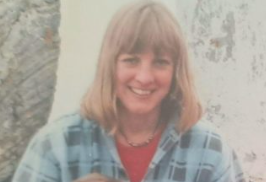
In 1993, Christine and Helene competed seriously in the Island Peaks Race but also ran well at home when both were selected for the WMRA championships in Gap, France and were the first two Scots to finish. Denis Bell wrote the official report on the Scottish team performance for the ‘Fellrunner’ magazine, the report on the Ladies race reads. “In the Ladies event, Helene led up the long drag halfway through the field and held on throughout with the gaps well established in front and behind. Penny had a slow start and came through about 15 places and was eventually hauled in by Dawn Kenwright (Wales) who also came through and pipped Christine; the Ladies generally captured a couple of places on the descent. A tidy bit of packing to get eleventh overall. Elspeth put in a strong descent also to get 4 places and went on strongly to finish on the last gentle run in (1 km) (a very tough exposure to her third international event.”
Helene raced a lot that year with several impressive victories (eg Stuc a Chroin where she won by 12 minutes from the next Lady) but Christine adopted a lighter approach to racing with the following notable events.
| Date |
Event |
Position |
Time |
Comment |
|---|
| 13th February 1993 |
Tiso Carnethy |
2nd Lady/1st veteran |
63:20 (Helene 1st 61:56) |
| 8th May |
1993 |
Ben Lomond Hill Race |
1st Lady |
49th overall |
1:23:54 (2nd E Scott) |
| 21st May |
1993 |
Island Peaks Race |
5th/1st Ladies |
12:17:48 |
|
| 5th September 1993 |
Gap |
29th – Helene Diamantides; 41st – Christine Menhennet; 42nd Penny Rother; 47th – Elspeth Scott. |
*
In the Ben Lomond race on 7th May 1994 when she finished second behind Joyce Salvona in 1:34:40. Christine liked the race and has a series of very good races and times in it.*
An indication of how well she ran in 1995, Christine finished the year with a double appearance in the British Fell Running Championship: third in the Veteran Ladies category but an even more impressive fifth in the Open category which was won by Sarah Rowell from Angela Mudge. In the Scottish Championships she was top of the rankings in first place with Angela Mudge second and Elspeth Scott third. It is appreciated that the championship is decided by places gained in a series of events over different distances and surfaces and not all runners cover as many as others but the standard is very high and her performances were first class.
Over the years Christine was consistently placed highly in the Hill Running Championships. The 1997 season was no different with Christine placed seventh and first veteran Lady in the Scottish Tiso hill running championship.
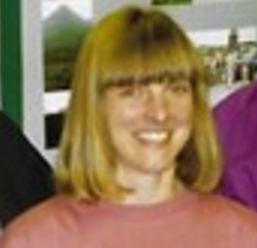
Her competitions were not all over long distances. As an example, two of the listed races in 1998 were the shorter faster ones in Strathyre and Melrose:
On Wednesday 17th June, 1998, she ran in the Ben Sheann race over 3 miles/1000 feet of ascent to win by a minute; and three days later
on 20th June, 1998, in the south of Scotland the Eildon Two Hills, 4.4 miles/1500 feet was the race. Finishing second in 37:17, Christine was first O35.
These were only two of the races that summer and at the end of the year she was ranked at Scottish and British levels. She was ninth of the top 22 ranked athletes in her category the British Individual Fell Running Championship. She was also second Scot. Nearer home in the Scottish rankings she was third woman behind Angela Mudge and Kate Jenkins and first O35 veteran.
There are not many results available throughout 1999 but we know that she was in awesome form when we see the repeat victory in the North-East. The photograph below is not one of a runner struggling gamely on! Look at the smile on the face and the lack of pursuing runners. Christine, pictured en route, liked the Great Wilderness Championship so much that she was back in 1999 when she finished ninth in a field of 49 runners (4 ladies) and set a record time for the race of 3:21:36.
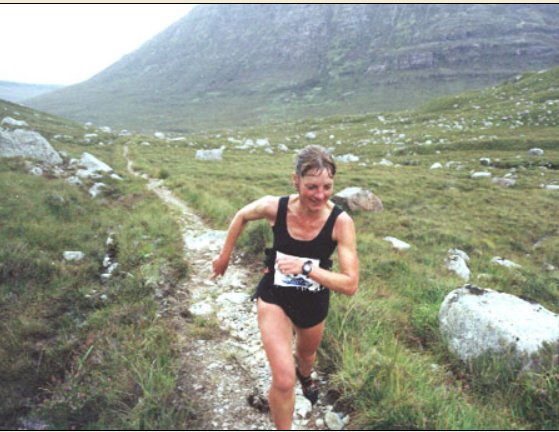
Photograph by Paul Wright

